#parallels with 20th century european fascism
Explore tagged Tumblr posts
Text
youtube
^^^ A new ad by The Lincoln Project.
Trump doesn't even try to hide his Nazism any more. Pro-democracy Americans need to vigorously point out the parallels.
Not long after Trump took office, historian Timothy Snyder wrote a book called On Tyranny: Twenty Lessons From the Twentieth Century. It became a national bestseller. More recently a graphic version was published. Whichever edition you choose, it's an excellent read by one of America's greatest living historians.
I have indeed read it. It's well written and it isn't long. Features of the rise of European fascism in the last century are described and related to the situation in the US in this century. It makes an excellent present – especially for people graduating this year.
#the lincoln project#donald trump#maga#fascism#nazism#adolph hitler#parallels with 20th century european fascism#books#on tyranny: twenty lessons from the twentieth century#timothy snyder#vote blue no matter who#election 2024#Youtube
16 notes
·
View notes
Text
This is truly a ridiculous time for my “I was majoring in history (with a particular interest for 18th-mid 20th century European history) and minoring in Jewish Studies” ass to be alive.
Catch me tearing my hair out because there are too many parallels between current events and all the shit I had to write papers on.
Fascism. Disease. Proto-T€RFs. The dangers caused by White Womanhood™️. War in Europe. Antisemitism. Etc etc etc etc.
And then to see the most stupid ass takes on these things being shared by idiots with massive platforms. *SCREAMSSSSSSSS*
4 notes
·
View notes
Link
By Gary Brecher.Republished from the Radio War Nerd subscriber newsletter. Subscribe to Radio War Nerd co-hosted with Mark Ames for podcasts, newsletters and more!. Posted with THE EXILED.
There’s a gigantic, well-organized, extremely violent fascist group with tens of thousands of active members in Germany right now.
And nobody notices.
You’d think all the fascist-hunters would have sniffed it out by now, but it goes right by them as if these guys were invisible.
Which is odd, because this group is not trying to hide, or pretending to be harmless. They’re not shy about it, and it’s not just talk. They have quite a record. They’ve been rampaging for decades, and if anything they’re stronger now than they used to be. They’re closely linked to CIA and Nazi groups; they’re very busy beating, burning, and murdering minorities of all kinds, and boast quite openly about hating literally everyone who’s not a member of their own ethnic group and sect, even suggesting that members go on “hunting expeditions” against minorities which they’d already almost wiped out back in the 20th century.
This group recently held massive, open rallies in the cities of Germany, and it’s only in the last few years that the government has even attempted to ban the public symbols and salutes of this massive fascist group.
There’s something grotesquely comic about this. We have a swarm of fascist-spotters who’ve spent the last few decades waiting for fascism to emerge in Germany when it was marching around, shouting at the top of its lungs, beating minorities, celebrating genocide, and supporting ethnic cleansing right in front of their damn faces.
I’m talking about the Gray Wolves. And I defy anyone to find a more successful, out-front, no-kidding, massive, effective, ruthless fascist organization anywhere in the world. They’re adapting quickly, and even have their own fierce Wiki defenders.
Here are a few highlights from their long, successful career:
In 1978, Gray Wolves started pogroms against Alevi Kurds in Maras (also known as Kahramanmaras) in South-Central Anatolia.
Location is important here. Maras is due north of Aleppo across the Syrian border, NW of Kobane, and above all just up the road from Gazantiep. Gazantiep is a key city for right-wing Turkish nationalists, a city dominated not just by people who are ethnically Turkish but who identify as rightwing Turks of the most intensely nationalist kind. This kind of population lives in a state of siege, glories in that feeling, and is almost always willing to lash out against the sea of minorities they imagine surrounding them. That’s why Gazantiep keeps making the news as a nice convenient safe house for IS and their Turkish allies, some of whom killed 57 Kurds at a wedding in 2016.
It’s important to emphasize that people who are ethnically Turkish are not a bloc. Some of the bravest people on earth, languishing in the Turkish state’s prisons or buried in unmarked graves, are proudly Turkish by ancestry.
And then there are the young men who join the Gray Wolves. Those men are murderous fascists, and it’s cowardice to pretend not to see that.
Violence by these men against minorities has never stopped, but it hit its peak — more like the highest peak in a mountain-range of a graph — in 1978, before the Anglosphere had any handle on sectarian violence in the Middle East.
The target of the Gray Wolves in Maras was a double minority: Alevi Kurds. Alevi Muslims are often considered heretics by Salafists and other Sunni fundamentalists. They were massacred with impunity in Ottoman pogroms. Erdogan’s AK Party, which very much wants to revive Ottoman practice and Ottoman borders, openly considers the Alevi heretics fair game for the Gray Wolves’s death squads.
Those who were killed in 1978 were not only Alevi, but Kurds — and the Turkish state, which embraced Wilsonian ethnic nationality with a vengeance, a terrible vengeance, hates Kurds simply for being Kurds. So the Kurdish Alevi of Maras were a natural target twice-over.
The campaign against them built up for weeks, as pogroms usually do, with the unpredictable pace partly a result of working with unstable, violent mobs but also part of a strategy to terrorize the victims, who never know when things will go from bad (very bad) to even-worse.
The details of the massacre are very typical, sickening but not unusual:
Witnesses to the massacre.
Seyho Demir: “The Maras Police Chief at the time was Abdülkadir Aksu, Minister of the Interior in the last AKP government. The massacre was organised by MIT (the Turkish secret service), the Nationalist Movement Party (MHP) and the Islamists together… As soon as I heard about the massacre, I went to Maras. In the morning I went to Maras State Hospital. There I met a nurse I knew…When she saw me, she was surprised: ‘Seyho, where have you come from? They are killing everyone here. They have taken at least ten lightly-wounded people from the hospital downstairs and killed them.’ This was done under the control of the head physician of the Maras State Hospital. Everyone knows that such a big massacre cannot be carried out without state involvement. In the Yörükselim neighbourhood they cut a pregnant woman open with a bayonet. They took out the eight-month foetus, shouting “Allah Allah” and hung it from an electricity pole with a hook. The pictures of that savagery were published in the newspapers that day. The lawyer Halil Güllüoglu followed the Maras massacre case. The files he had were never made public. He was killed for pursuing the case anyway. Let them make those files public, then the role of the state will become clear.”
Meryem Polat: “They started in the morning, burning all the houses, and continued into the afternoon. A child was burned in a boiler. They sacked everything. We were in the water in the cellar, above us were wooden boards. The boards were burning and falling on top of us. My house was reduced to ashes. We were eight people in the cellar; they did not see us and left.”(EZÖ/TK/AG)
All accounts agree that the massacre not only happened with state collusion but state encouragement. No one was punished. Many were, in fact, promoted, and hold high positions in Erdogan’s government today.
That’s the pattern here: the Gray Wolves as the street-fighting wing of the state. The parallel is closer to Indonesian Islamists in 1965 than the SA in 1930s Germany, but so many people have trouble taking any fascism clearly unless it can be soldered to 1930s Germany that I may as well make the analogy for, as they say in the academic biz, heuristic purposes.
The Gray Wolves ideology is very widespread and acceptable in many (not all) communities in Turkey. This leads to a lot of more or less lone-wolf killings (as it were), as when a soldier who was a member of the Gray Wolves killed a fellow soldier for being an Armenian a few years ago.
Older readers might remember the attempted assassination of Pope John Paul II back in 1979.
The assassin was one Mehmet Ali Agca, a longtime member of the Gray Wolves.
He had a track record of killing leftists and other enemies on behalf of the “Idealists” (seriously, that’s what the Wolves call themselves):
“The weapon used in the Feb. 1, 1979, murder of a Turkish newspaper editor, Abdi Ipekci, for which Mr. Agca was convicted, was supplied by a member of the Idealist Clubs, according to the Turkish authorities. Other members helped Mr. Agca escape from prison. Still others prepared a false passport for him. And on the day of the killing, he went to the National Action Party offices.”
Note the familiar pattern: Ali Agca kills a leftist editor who’s annoying the Turkish state, gets caught, and manages to escape with a lot of help from Turkish intelligence.
They hardly bothered to hide their collusion in the escape. The Turkish state was killing a lot of leftists, a lot of intellectuals, a lot of minorities — the usual suspects for classic fascists like Ali Agca.
But as you older readers might recall, nobody in the media talked about Ali Agca as a Turkish fascist. He was, for Cold-War purposes, smeared as a Bulgarian agent.
The “Bulgarian connection” never made much sense, but it served the US/UK/Israel/Saudi intelligence agencies’ PR purposes. Remember, Turkey is NATO — very, very NATO.
NATO might survive the loss of many other small European states, but it could not survive losing Turkey. So the US/UK state will always side with the Turkish state and help them cover up fascist atrocities, blaming them on the Soviets until those useful patsies took their final dive.
Blaming Bulgaria rather than the obvious suspects, the Gray Wolves to which this thug Ali Agca had been murderously loyal all his life, was especially bizarre since there was an obvious sectarian motive: the Gray Wolves hate Christians, as they hate all other minorities, ethnic or religious, and make a point of staging provocations at all occasions when the remnants of what was once a huge Christian minority dare to show themselves in public.
Orthodox Christians are the Wolves’ preferred prey. They prefer not to do anything too bloody to high-profile Western targets like a pope, but when you squirt sectarian hate into weak minds and itchy trigger fingers for generations, some of the lads are going to pick the wrong victim.
Perhaps that’s what happened when Ali Agca went from NATO-approved murderer of leftists and Kurds, to shooting the Pope. We’ll never know, because it was quickly twisted into the ridiculous “Bulgaria did it” farce by the guys who enjoy a few cocktails with their opposite numbers from Ankara at all those NATO conferences.
And we’ll never know how much daily violence this massive fascist gang inflicts. Occasionally the Turkish state gets irritated enough to send a suicide bomber or two to kill Kurdish peace demonstrators, as it did in Ankara in 2015, killing 86 demonstrators and maiming a hundred more. But that state, our NATO ally, supports a whole madhouse of Arab and Turkmen jihadis as well as its own stable of disposable Gray Wolves assassins, so it may never be clear whether it was the Wolves, precisely, who pressed the detonators.
But it’s a statistical certainty that somewhere along the long line from greenlighting an attack like this and sending red-hot ball bearings splattering into the bodies of teenagers with peace banners, many of the men involved were members in good standing of the good ol’ Wolves.
Violence by the Gray Wolves is a constant in Turkey, usually unreported — especially now that Erdogan’s party has imprisoned thousands of journalists and intellectuals, and terrorized the rest into quietism or collusion. We may never know how many Kurds are murdered daily in the southeast of Anatolia, because no one who matters, in the Turkish state or its many powerful allies in the West (e.g. the Michael Flynn story) want you to know about it. It’s rare for those stories to make the news at all, but God knows you can’t forget them once you’ve read them.
In fact the Gray Wolves are going mainstream, and winning a lot of votes.
Fascism is mainstream in Turkey, getting more mainstream all the time — and has been since the violent dissolution of the Ottoman Empire. The Gray Wolves have quite a pedigree, a classic fascist genealogy.
Fascism is often strongest in the ruins of a defeated empire, and that was the situation in the former Ottoman Empire in the 1920s. The Empire had once ruled from Central Europe to Iraq, flowing and ebbing over the centuries (with a peak in the 16th century). At its peak, it was a fearsome conquering force.
There’s a great novel by the Albanian writer Ismail Kadare detailing the unstoppable waves of special forces that the Empire could unleash on strongpoints that held out against conquest.
The Ottomans took a long time to fall from that 16th c. peak. They were still around, partly because Britain and France always supported them against the bogeyman of the late Victorian Era, the Russian Threat.
Propped up by the two big powers of Europe, the Empire managed to survive a coup in 1908 by young officers who would go on to a career in defeat and genocide, because they guessed wrong on which side would win the oncoming Great War.
The Young Turks, as these officers were called, sided with the up-and-coming, efficient military of the neighboring empire: Germany. They guessed wrong, but not before they managed to exterminate the harmless Armenians who had recently been patronized as Turkey’s “model minority” for their docility. And this genocide went so well, so quietly, that Hitler, contemplating the genocide of the European Jews, allegedly demanded of any squeamish nay-sayers “Who remembers the Armenians?”
You get a lot of horrible echoes like that in this story. At any rate, no one cared to remember or notice the extermination of the Armenians, but the winners at Versailles were typically vengeful against the former Ottoman Empire — not by any means for wiping out the Armenians, but for being German allies, and losing.
Britain and France, now joined by the US, were as vengeful toward the former Empire as they had been lenient during its bloody final years. Ottoman rule over non-Turkish territory was erased. For a few years there was some doubt whether even Anatolia would remain a Turkish state.
Then, as most of you know, came Mustafa Kemal, soon to become Kemal Ataturk, a hero of Gallipoli (a Turkish/Ottoman victory that stood out proudly in the great defeat).
Ataturk was a typical elite young officer of the early 20th c. Those were very dangerous people, those young officers. Often impressive individuals, but completely ruthless and immensely fond of violence. That goes for all of them, right across the Continent — Hell, right across the world.
Ataturk formed a nucleus of former officers from the Great War. (Again, the international echoes are clear enough; suffice to say that these guys were the most dangerous, formidable demographic in a few generations, perhaps since the emergence of the Napoleonic elite.) They fought well, and then they went about making Turkey a monoethnic state, without mercy.
For a while, that state was professedly secular, but since it had already killed or driven out most religious minorities, the monoethnic state became, under the AK party, avowedly mono-sectarian as well.
The current chant of the Wolves many, many supporters is “My heart is Turkish and my soul is Muslim!” You must be both: ethnically Turkish and orthodox, Sunni Muslim as well. No mercy for anyone who fails either test, which means that a lot of Kurds, a lot of Alevis, a lot of secular Leftists, end up dead or in prison.
The evolution of the Gray Wolves is a classic fascist Genesis story, and the behavior of its hundreds of thousands (perhaps millions) of supporters is classic fascist violence. Why don’t more people notice that?
I hate to speculate, because the range of possible answers all boils down to cowardice, conformity, and the odd Euro-centrism one finds in the strangest places. They don’t get noticed because they’re not European, maybe? Fascism of the 1930s was European, and that’s the only kind amateurs notice? Odd, because Turkey is European enough to be the cornerstone of NATO.
This would not be the first time that the interests of what you could call the NATO Deep State aligned all too perfectly with the more gullible pockets of the Left. In fact, it’s very closely related to the phenomenon of not noticing, or trying very hard not to notice, the sectarian ultra-violence of the Syrian “rebels.” But this time, since Turkey is a NATO ally, it’s the violence of the state and its fascist proxies that is ignored. I struggle to come up with any other reason that the Gray Wolves get so little attention.
All I know is that we have a massive, ultra-violent, highly effective, classically fascist movement killing minorities every single day, and there’s an odd silence about it.
I would love to ask one of the innumerable online fascist hunters why they hunt stray curs and slink silently past the cold stare of the Gray Wolves. Perhaps it’s not so much any of the excuses I suggested above; perhaps some hunters just prefer smaller, easy prey to the real thing.
Gary Brecher is the nom de guerre-nerd of John Dolan. Buy his book The War Nerd Iliad. Hear him read his comic memoir Pleasant Hell in audiobook format.
Subscribe to the Radio War Nerd podcast & newsletter!
#war nerd#gary brecher#john dolan#gray wolves#fascists#turkey#young turks#kemal atatürk#kurds#alevi muslims#NATO#erdogan#ottoman empire#neo-ottoman empire#ethnic cleansing#ali acga#turkish nationalists#turkish nationalism#nationalism is cancer#imperialism
21 notes
·
View notes
Text
On tyranny timothy snyder

On Tyranny is a call to arms and a guide to resistance, with invaluable ideas for how we can preserve our freedoms in the uncertain years to come. A graphic edition of historian Timothy Snyders bestselling book of lessons for surviving and resisting Americas arc toward authoritarianism, featuring the. On Tyranny author Timothy Snyder parallels the rise of fascism in the 1930s to the Trump administration, and breaks down how facts are the enemy of tyranny. Our one advantage is that we might learn from their experience. We are no wiser than the Europeans who saw democracy yield to fascism, Nazism, or communism. Today, our political order faces new threats, not unlike the totalitarianism of the twentieth century. The Founding Fathers tried to protect us from the threat they knew, the tyranny that overcame ancient democracy. 1 NEW YORK TIMES BESTSELLER A bracing (Vox) guide for surviving and resisting Americas turn towards authoritarianism, from a rising public.22. He has written the rare kind of book that can be read in one sitting but will keep you coming back to help regain your bearings.”-Masha Gessen On Tyranny, by Timothy Snyder, PhD, describes how tyrants have dismantled 20th-century republics and replaced them with totalitarian regimes, and how threats to. “Timothy Snyder reasons with unparalleled clarity, throwing the past and future into sharp relief. A “bracing” ( Vox) guide for surviving and resisting America’s turn towards authoritarianism, from “a rising public intellectual unafraid to make bold connections between past and present” ( The New York Times).

1 note
·
View note
Text
MANIFESTO LAUNCH
Red Alan's Manifesto by Grayson Perry, 2014
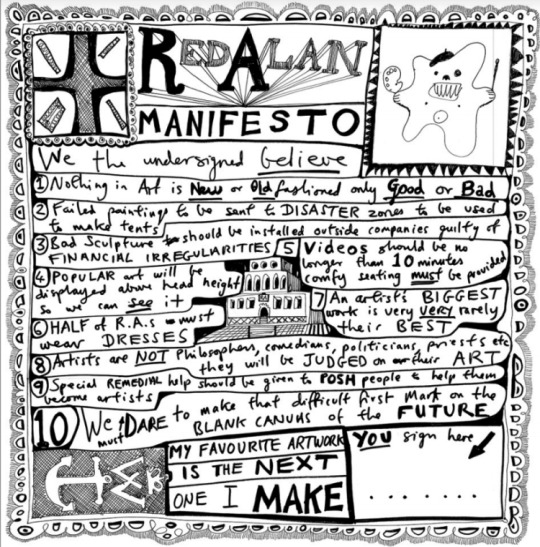
Poetry | Political Statement
Possibly Gender Fluid
Documentaries
Write a Manifesto - Create Poster
Manifestos are usually written in a group
Political Ethos
Gender Issues
ASSESS WHAT IS IMPORTANT TO YOU - what do I want to say within my art
A manifesto is a public declaration, often political in nature, of a group or individual’s principles, beliefs, and intended courses of action.

10 game-changing art manifestos
By Harriet Baker (Royal Academy)
Published 10 April 2015
Some time between 1966-76, Richard Diebenkorn wrote ten notes on beginning a painting. Described by the critic John Elderfield as a set of “artistic intentions,” they are a valuable insight into the mind of the artist, revealing some of the ways that Diebenkorn challenged himself in his work. Diebenkorn, of course, was not the first artist to lay out his beliefs. From Joshua Reynolds’s lofty Discourses to the impassioned manifestos of the early 20th-century’s avant- garde, artists have laid out pages of their visions for art, many of which changed the course of art history. And while contemporary artists continue to set their objectives on paper, it is often done with a more wry and humorous touch. The result is a collection of imperfect but fascinating ideas about what art should be.
Discourses on Art, Sir Joshua Reynolds,
1769-1790
I wished you to be persuaded, that success in your art depends almost entirely on your own industry; but the industry which I principally recommend, is not the industry of the hands, but of the mind... We may go so far as to assert, that a painter stands in need of more knowledge than is to be picked off his pallet, or collected by looking on his model, whether it be in life or in picture. He can never be a great artist, who is grossly illiterate... He ought to know something concerning the mind, as well as a great deal concerning the body of man.
Sir Joshua Reynolds PRA, Discourses VII, 1769
Sir Joshua Reynolds, Self-Portrait as a Figure of Horror, c.1784

Reynolds Discourses on Art, now considered to be the founding text of British painting theory, elevated art as an activity of the mind, not the hand, and called on painters to imbue their work with much more than simply what they saw in front of them.
The Discourses were very influential, but controversial too; William Blake annotated his copy furiously, noting his “indignation and resentment” at Reynolds’s ideas, while the Pre-Raphaelites accused Reynolds of ignoring the truth in favour of ideal beauty.
ART HISTORY
The Founding and Manifesto of Futurism, FT Marinetti, 1909
1. We intend to sing the love of danger, the habit of energy and fearlessness.
2. Courage, boldness, and rebellion will be the essential elements in our poetry.
3. Up to now, literature has extolled a contemplative stillness, rapture and reverie. We intend to glorify aggressive action, a restive wakefulness, life at the double, the slap and the punching fist.
F.T. Marinetti, 1909
THE FUTURISTS
The Futurists published a huge number of different manifestos, using them to communicate their aesthetic, political, and social ideals. The scale with which the Futurists created and disseminated their manifestos was unprecedented, allowing them to transmit their ideas to a wider audience.
Many Italian Futurists supported Fascism and parallels can be drawn between the two movements. Like the Fascists, the Futurists were strongly patriotic, excited by violence and opposed to parliamentary democracy. When Mussolini took power in 1922 it brought Futurism official acceptance, but, later, this adversely affected many of the artists as they became tainted by association.
The Art of the Manifesto (or Art Manifestos)
By Eulàlia Iglésias
“We want to sing the love of danger, the habit of danger and of temerity.” Thus begins the Futurist Manifesto that Filippo Tommaso Marinetti published in French newspaper Le Figaro on February 20th, 1909.
A spectre haunted European art during the first years of the 20th century. Imbued with the spirit of the new age, fascinated by the technological innovations shown in different fields, and sympathisers of the many social and political revolutions that were arising throughout the continent, a generation of youngsters decided to break with the academic legacy and canon in force since the Renaissance to create art more in harmony with their own times: the avant-gardists. And the way to proclaim this new art was through the use of manifestos.
Up to Marinetti’s, manifestos had been circumscribed to the political sphere. By putting pen to
paper to define their intentions and affinities, these young artists declared the pragmatic character of the avant-garde. They created and destroyed in order to show their rejection of tradition and their longing to change life and transform society. The term ‘avant-garde’ has a clear military connotation, and manifestos were a war declaration of sorts against the world as they knew it.
Futurism was an Italian art movement that aimed to capture the dynamism and energy of the modern world in art. The Futurists were well versed in the latest developments in science and philosophy, and particularly fascinated with aviation and cinematography.
Futurist artists denounced the past, as they felt the weight of past cultures was extremely oppressive, particularly in Italy.
The Futurists instead proposed an art that celebrated modernity and its industry and technology.
Elasticity (detail), (1912), Umberto Boccioni.

Unique Forms of Continuity in Space (1913), Umberto Boccioni
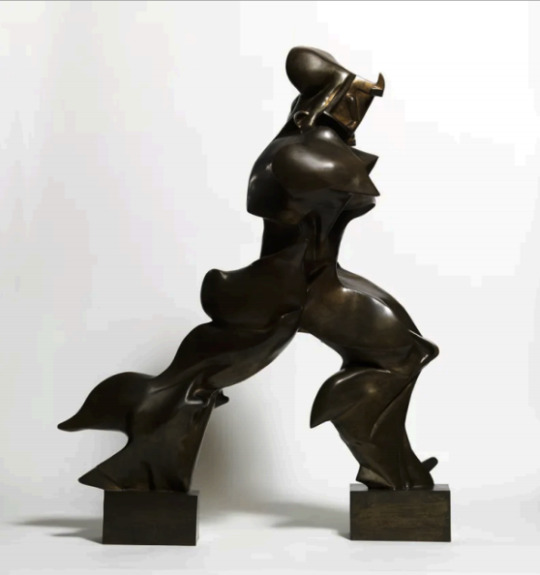
Giacomo Balla Abstract Speed, The Car has Passed 1913

Mario Sironi’s 1918 drawing ‘Uomo Nuovo’ (New Man)
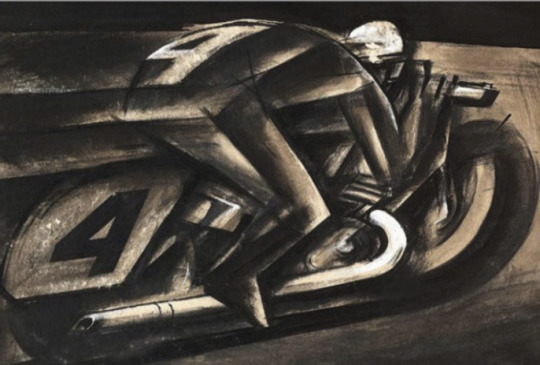
Jacques-Henri Lartigue, 1913

László Moholy-Nagy Light Prop for an Electric Stage

László Moholy-Nagy- Dual Form with Chromium Rods

As early as 1922, László Moholy-Nagy (1895–1946) began to make metal sculptures. He believed that new materials called for a new kind of art, and metal was appealing for its connection to industry and modern machinery.
Dada manifesto, Tristan Tzara, 1918
Tristan Tzara was a French poet and essayist, famous for founding Dada in Zurich in 1916 and writing the founding manifesto.
Spanning a wide variety of mediums and forms – from photography and performance art to painting and collage – the Dada movement was born out of a reaction against nationalism and rationalism, which these artists believed to have caused the First World War.
Though the movement was far from coherent, its key figures – including Hans Arp, Kurt Schwitters and Hannah Hoch – produced highly political and irreverent works influenced by Cubism, Futurism and Constructivism.
Jean Hans Arp, bois gravé et collage pour la couverture de Dada 4-5, 1919
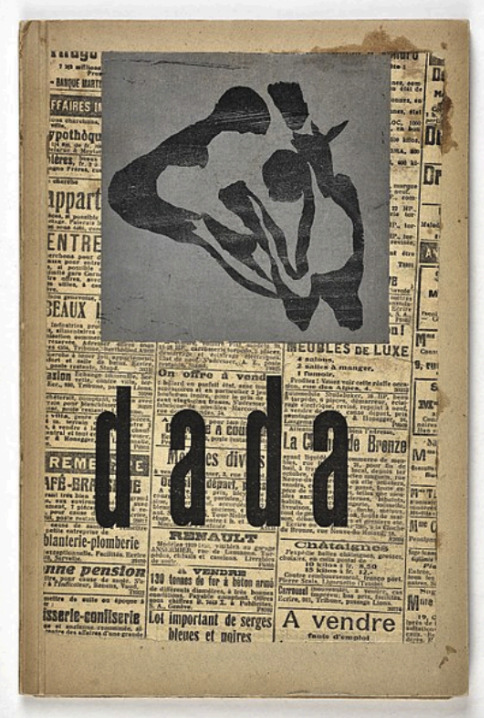
Hannah Höch
Known for her incisively political collage and photomontage works, Dada artist Hannah Höch appropriated and rearranged images and text from the mass media to critique the failings of the Weimar German Government.
Höch drew inspiration from the collage work of Pablo Picasso and fellow Dada exponent Kurt Schwitters, and her own compositions share with those artists a similarly dynamic and layered style.
She rejected the German government, but often focused her criticism more narrowly on gender issues, and is recognized as a pioneering feminist artist for works such as Das schöne Mädchen (The Beautiful Girl), (1920), an evocative visual reaction to the birth of industrial advertising and ideals of beauty it furthered.
Hannah Höch, Das schöne Mädchen (The Beautiful Girl), (1920)
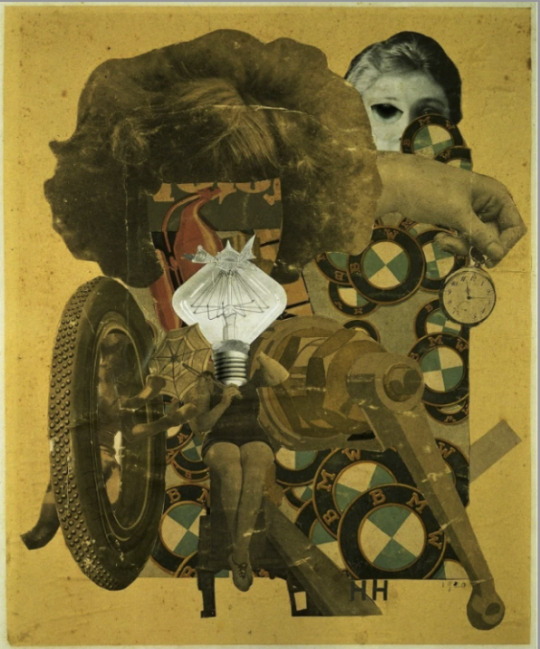
Hannah Höch, Für ein Fest gemacht (Made for a Party) 1936

Hannah Höch, Cut with the Dada Kitchen Knife through the Last Weimar Beer-Belly Cultural Epoch in Germany, 1919
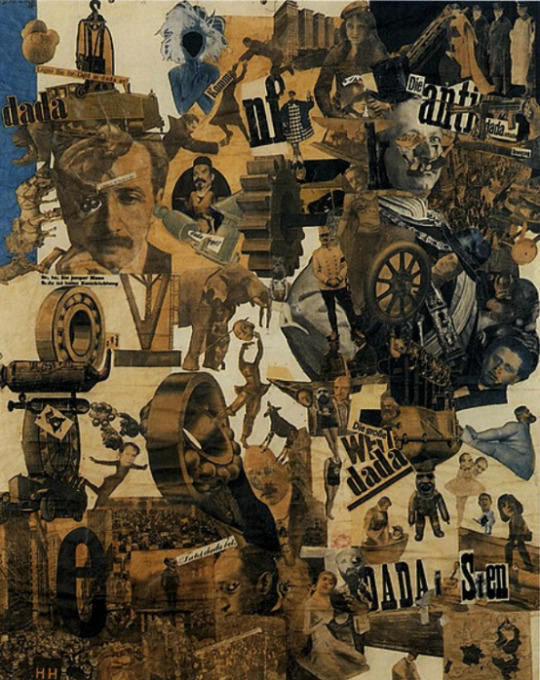
Man Ray, Rayograph, 1922

Man Ray. Untitled Rayograph, 1922.

Surrealism was an artistic, intellectual, and literary movement led by poet André Breton from 1924 through World War II. The Surrealists sought to overthrow the oppressive rules of modern society by demolishing its backbone of rational thought. To do so, they attempted to tap into the “superior reality” of the subconscious mind. “Completely against the tide,” said Breton, “in a violent reaction against the impoverishment and sterility of thought processes that resulted from centuries of rationalism, we turned toward the marvellous and advocated it unconditionally”.
Many of the tenets of Surrealism, including an emphasis on automatism, experimental uses of language, and found objects, had been present to some degree in the Dada movement that preceded it. However, the Surrealists systematized these strategies within the framework of psychologist Sigmund Freud’s theories on dreams and the subconscious mind.
In his 1924 Surrealist Manifesto, Breton defined Surrealism as: “Psychic automatism in its pure state, by which one proposes to express...the actual functioning of thought...in the absence of any control exercised by reason, exempt from any aesthetic or moral concern.”
Max Ernst. Loplop Introduces Members of the Surrealist Group. 1931
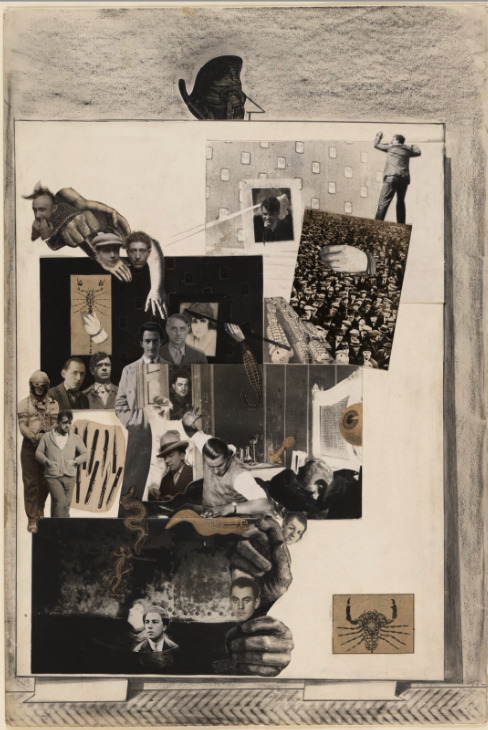
Hans Bellmer. Plate from La Poupée. 1936
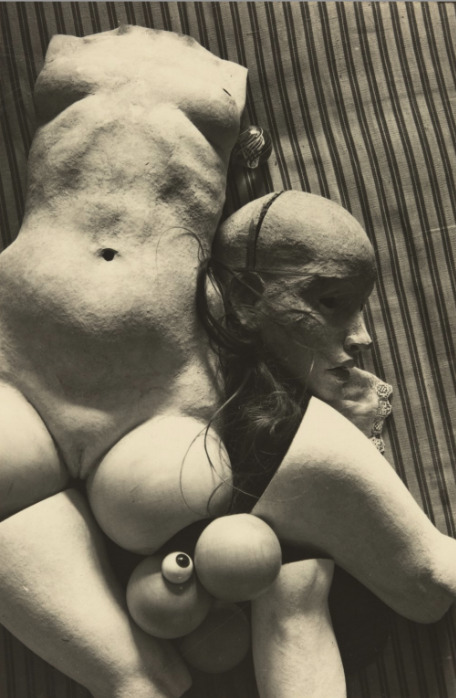
Lee Miller, Portrait of Space, Nr Siwa, Egypt, 1937.

SITUATIONIST INTERNATIONAL (IS)
Were a revolutionary alliance of European avant- garde artists, writers and poets formed at a conference in Italy in 1957.
The Situationist International brought together experimental poetry, avant-garde art, and radical social criticism to explore new techniques of engagement in cultural protest and revolutionary praxis.
When the Situationist International was first formed, it had a predominantly artistic focus; Gradually, however, that focus shifted more towards revolutionary and political theory.
It was anti-capitalist, and left-leaning, but was also committed to the disruption of the hegemonic politics of Europe in the late 20th century through artistic praxis as well as political agitation. Although eventually fracturing, SI provided a blueprint for rebels and artistic dissidents still followed today.
The notion of "Spectacle", originally outlined by Guy Debord in various Situationist writings, is key to understanding both the conceptual underpinnings of SI and its enduring legacy. The idea of a permanently distracting and preoccupying spectacle, which obfuscates the oppressive nature of capitalism, has been adopted by artists, activists, critics and academics as a key philosophical concept in the current moment of late capitalism.
Although a collaborative and supposedly open movement, SI adhered relatively rigidly to the direction of Guy Debord and the key ideas and artistic strategies he identified. This is somewhat ironic, as it was actually the wider dissemination and public take up of their ideas that ensured their longevity long after the group fragmented.
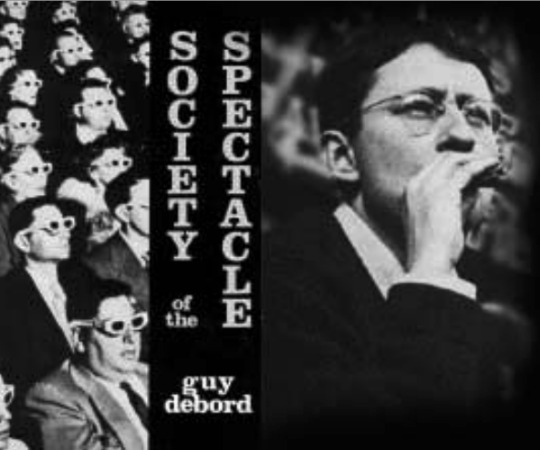
Asger Jorn experimented with spontaneous line and semi- figurative representation in paintings he called “modifications.” His works attempted to change people’s behaviours towards art, writing, and the spaces they lived in.
“A creative train of thought is set off by the unexpected, the unknown, the accidental, the disorderly, the absurd, the impossible”
Asger Jorn
Jorn was one of the few artists who identified themselves as Situationists during the main period of the movement’s activity but the political rhetoric surrounding the movement and it’s manifesto influenced the work of many future artists.
Asger Jorn, Modification with Brittany Woman, 1962.

Situationism as an art movement did not produce too many artworks as a matter of fact, with the exception of Asger Jorn, the movement’s output is next to none.
However, Situationism is credited with providing some of the most revolutionary theories at the time, concepts that heavily impacted the art scenes for decades.
Many of their game-changing ideas can still be found in today’s contemporary art.
The political background of SI influenced the evolution of music, Punk in particular. Also the political aspect of the movements is recorded as being instrumental in the origins of street art (graffiti), performance, and installation art.
Protests in Paris during May ’68
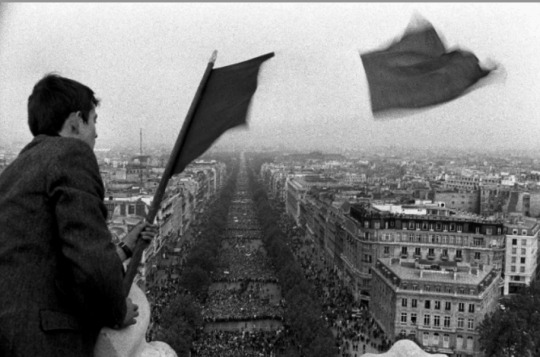
Peter Kennard, Haywain with Cruise Missiles 1981 & Defended to Death 1983


“Never Again’, Peter Kennard

Crushed Missile (1980) by Peter Kennard

Krzysztof Wodiczko, Hirschhorn Museum Washington DC 2018 and Projection on to South Africa House 1985
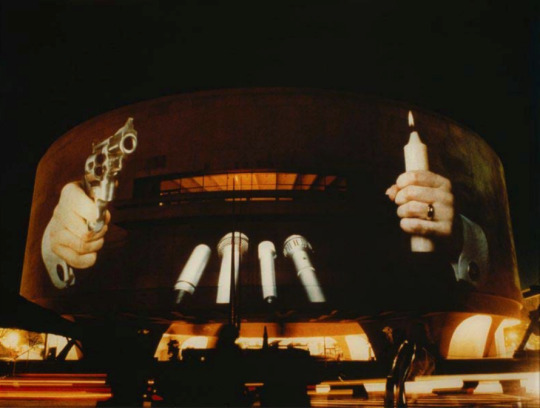
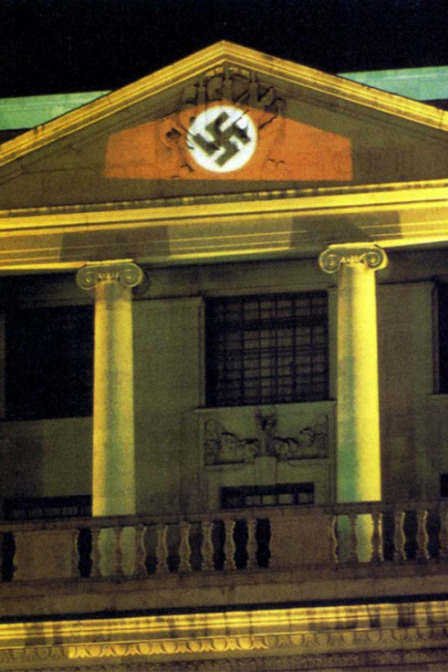
The Guerilla Girls, 1985-90
In 1984, a group of anonymous women, wearing gorilla masks, picketed the Museum of Modern Art in New York. MoMA was opening a show which purported to be a definitive survey of contemporary art, and yet out of the 169 artists featured in the show, only 13 were female. Since their inception, the group have worked to expose the under- representation of women in the art world by targeting galleries, art dealers and critics. Their manifesto comes in the form of their famous slogan artworks.
Guerrilla Girls, no title, 1985-90

Since their inception in 1984 the Guerrilla Girls have been working to expose sexual and racial discrimination in the art world, particularly in New York, and in the wider cultural arena.
The group’s members protect their identities by wearing gorilla masks in public and by assuming pseudonyms taken from such deceased famous female figures as the writer Gertrude Stein (1874-1946) and the artist Frida Kahlo (1907-54).
Guerrilla Girls, The Advantages of Being A Woman Artist, 1988

The Stuckist Manifesto, 1999
Established in 1999, the British group the The Stuckists proclaimed themselves to be “Against conceptualism, hedonism and the cult of the ego-artist.” The movement was formed by Billy Childish and Charles Thomson to celebrate and promote figurative painting in a reaction to the proliferation of conceptual art. Every year, the Stuckists famously demonstrate outside Tate Britain as the winner of the Turner Prize is announced.
1. Stuckism is the quest for authenticity.
2. Painting is the medium of self-discovery.
3. Stuckism proposes a model of art which is holistic.
4. Artists who don’t paint aren’t artists.
5. Art that has to be in a gallery to be art isn’t art.
The Stuckists, 1999
"Your paintings are stuck, you are stuck! Stuck! Stuck! Stuck!”
Tracey Emin
Billy Childish, Hand on Face, oil on canvas, 2000

Possibly the best-known recent example of an artistic manifesto in the digital age is that of The Stuckists – an art movement established in the UK 1999, which has now grown to at least 233 groups in 52 countries.
Its founding members, Billy Childish and Charles Thomson, rejected conceptual art, instead advocating a return to figurative paintings with ‘spiritual value’.
The success of this movement (members of which continue to demonstrate against The Turner Prize at London’s Tate Britain every year), has spurred other contemporary artists into creating their own manifestos. For example, The Resurrection Of Beauty, written by philosopher and photographer, Mark Miremont, calls for a rejection of what he describes as “The sarcastic relativism of dada”.
Outside the Turner Prize, Tate Britain, 2005: Stuckists demonstrate against the purchase of Chris Ofili's The Upper Room. The cutout is Tate chairman Paul Myners.
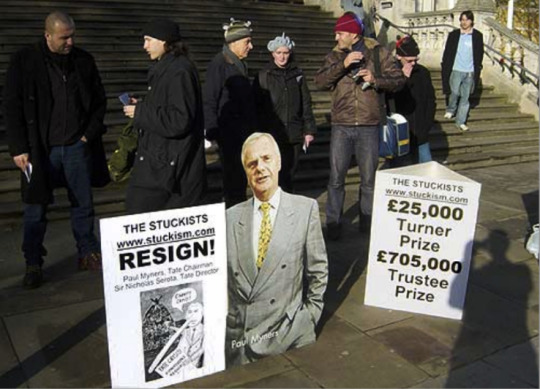
Manifestos within Photography
Brett Weston, Garden Apartment, New York

Group f/64
Formed in 1932, Group f/64 this group of so-called 'straight' photographers focused on the clarity and sharp definition of the un-manipulated photographic image. Committed to a practice of "pure photography",
Group f/64 encouraged the use of a large-format view camera in order to produce grain-free, sharply-detailed, high value contrast photographs. Group f/64 mounted a revolt against the dominant fashion within the art of photography which was to ape the painterly and graphic techniques associated with Bay Area Pictorialism. The members' preference was for a style of art photography that would fully promote the camera's unique mechanical qualities.
The original 11 members of Group f.64 were Ansel Adams, Imogen Cunningham, Edward Weston, Willard Van Dyke, Henry Swift, John Paul Edwards, Brett Weston, Consuelo Kanaga, Alma Lavenson, Sonya Noskowiak, and Preston Holder.
"Pure photography is defined as possessing no qualities of technique, composition or idea, derivative of any other art form." —Group f/64 Manifesto, August 1932
Dunes, Oceano, Edward Weston, 1936
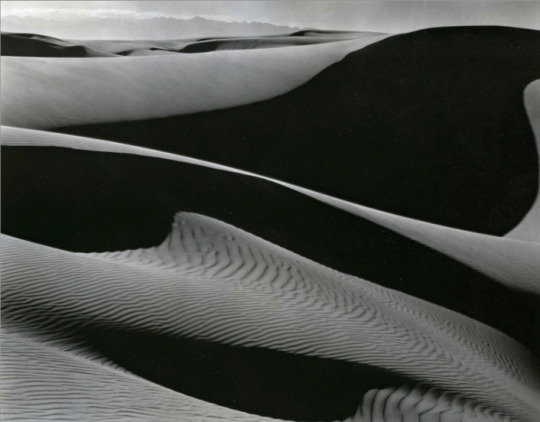
Half Dome, Apple Orchard, Yosemite, Ansel Adams, 1933.

Two Callas, Circa 1925, Imogen Cunningham
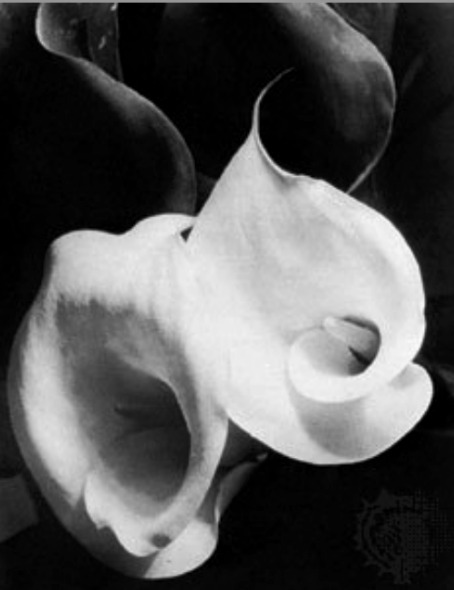
Group f/64 displayed the following manifesto at their 1932 exhibit:
The name of this Group is derived from a diaphragm number of the photographic lens. It signifies to a large extent the qualities of clearness and definition of the photographic image which is an important element in the work of members of this Group. The chief object of the Group is to present in frequent shows what it considers the best contemporary photography of the West; in addition to the showing of the work of its members, it will include prints from other photographers who evidence tendencies in their work similar to that of the Group.
Group f/64 is not pretending to cover the entire spectrum of photography or to indicate through its selection of members any deprecating opinion of the photographers who are not included in its shows. There are great number of serious workers in photography whose style and technique does not relate to the metier of the Group.
Group f/64 limits its members and invitational names to those workers who are striving to define photography as an art form by simple and direct presentation through purely photographic methods. The Group will show no work at any time that does not conform to its standards of pure photography. Pure photography is defined as possessing no qualities of technique, composition or idea, derivative of any other art form. The production of the "Pictorialist," on the other hand, indicates a devotion to principles of art which are directly related to painting and the graphic arts.
The members of Group f/64 believe that photography, as an art form, must develop along lines defined by the actualities and limitations of the photographic medium, and must always remain independent of ideological conventions of art and aesthetics that are reminiscent of a period and culture antedating the growth of the medium itself.
The Group will appreciate information regarding any serious work in photography that has escaped its attention, and is favourable towards establishing itself as a Forum of Modern Photography.
‘Magnum is a community of thought, a shared human quality, a curiosity about what is going on in the world, a respect for what is going on and a desire to transcribe it visually.’
Henri Cartier-Bresson
Behind the Gare Saint-Lazare, Henri Cartier-Bresson, 1932
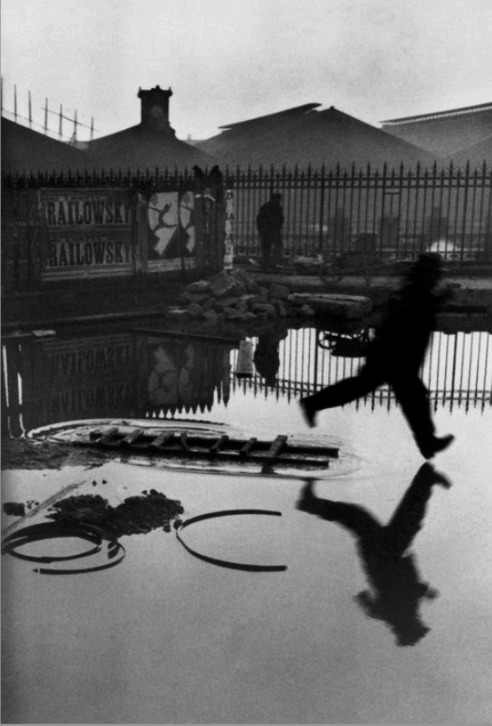
n 1947, following the aftermath of the Second World War, four pioneering photographers founded a now legendary alliance.
Combining an extraordinary range of individual styles into one powerful collaboration, Henri Cartier-Bresson, Robert Capa, George Rodger and David Seymour started, the most important artists’ cooperative ever created: The Magnum Photos agency.
Robert Capa US troops assault Omaha Beach during the D-Day landings (first assault), 1944.

“Capa was the boss because, for one thing, he kept on the lookout for stories for all the Magnum photographers. But equally vital were his experience, generosity, connections, aggressiveness, and the vision he had for Magnum, which kept us going. Since few of us were married, we had much time to spend together. We talked a lot, but rarely about photography. Our discussions were more often about politics or philosophy or racehorses, pretty girls, and money. We constantly looked at each other’s work, and criticism could be tough if the work did not measure up to the expected standard.”
Inge Morath
Magnum Photos represents some of the world’s most renowned photographers, maintaining its founding ideals and idiosyncratic mix of journalist, artist and storyteller. Our photographers share a vision to chronicle world events, people, places and culture with a powerful narrative that defies convention, shatters the status quo, redefines history and transforms lives. Magnum has documented most of the world’s major events and personalities since the 1930s; covering industry, society and people, places of interest, politics and news events, disasters and conflict.
Marc Riboud
An American young girl, Jan Rose Kasmire, confronts the American National Guard out the Pentagon durning the 1967 anti-Vietman march. (1967)

In planning the weekly news magazine, publisher Henry Luce circulated a confidential prospectus, within Time Inc. in 1936, which described his vision for the new ‘'Life'' magazine, and what he viewed as its unique purpose. ''Life'' magazine was to be the first publication, with a focus on photographs, that enabled the American public: “To see life; to see the world; to eyewitness great events; to watch the faces of the poor and the gestures of the proud; to see strange things — machines, armies, multitudes, shadows in the jungle and on the moon; to see man’s work — his paintings, towers and discoveries; to see things thousands of miles away, things hidden behind walls and within rooms, things dangerous to come to; the women that men love and many children; to see and take pleasure in seeing; to see and be amazed; to see and be instructed…”
On November 23, 1936, the first issue of the pictorial magazine Life is published, featuring the work of photographer Margaret Bourke-White.
Life was an overwhelming success in its first year of publication. Almost overnight, it changed the way people looked at the world by changing the way people could look at the world.
What the editors got from Bourke-White was a human document of American Frontier life & the photo essay format was born.

Photographer Margaret Bourke-White had been dispatched to the Northwest to photograph the multimillion dollar projects of the Columbia River Basin. What the editors expected were construction pictures as only Bourke-White could take them. What the editors got was a human document of American frontier life which, to them at least, was a revelation.”
(time.com)
Workers on Montana’s Fort Peck Dam blow off steam at night, 1936
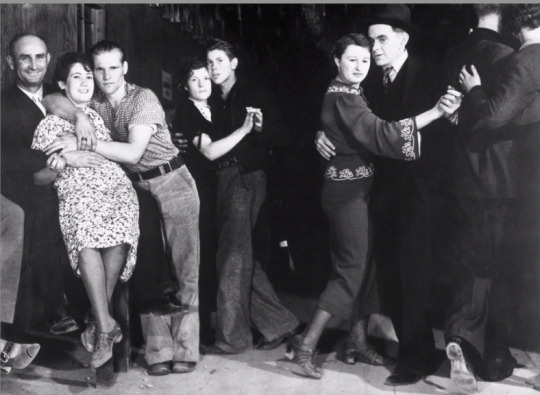
Luce, and Life magazine gave photographers the opportunity to delve into the stories of extraordinary people with the magazine’s photo essay series format which endured for years.
Across a dozen pages, and featuring more than 20 of the great W. Eugene Smith’ pictures, the story of a tireless South Carolina nurse and midwife names Made Callen opened a window on a world that, surely, countless LIFE reader had never seen - and perhaps, had never even imagined.

Cindy Sherman Interview 2019
What are your three top tips for becoming an artist?
Try to forget everything you learned about making art. Find a group of like-minded artists or creative people to hang out with. Take chances with what you do, make things that no one but
you will ever see, unless it turns out so good you want to share it.
Why do you make art?
It’s my life and it’s what I’m most passionate about. And it’s fun!
What’s the best piece of advice you’ve ever been given?
Find inspiration in reading
Cindy Sherman, Untitled A 1967

Anthropcene
Anthropocene is a multidisciplinary body of work by Edward Burtynsky, Jennifer Baichwal and Nicholas de Pencier, which includes a photobook, a museum exhibition, a feature-length documentary film, and an interactive educational website.
The project’s starting point is the research of the Anthropocene Working Group, an international body of scientists who argue that the Holocene epoch ended around 1950, and that we have officially entered the Anthropocene in recognition of profound and lasting human changes to the Earth’s system.
The Holocene is the name given to the last 11,700 years of the Earths history- the time since the end of the last ‘ice age.’ Since then, there have been small-scale climate shifts notably the ‘Little Ice Age’ between about 1200 and 1700 A.D but in general, the Holocene has been a relatively warm period in between ice ages.
My earliest understanding of deep time and our relationship to the geological history of the planet came from my passion for being in nature.
Coal Mine #1, North Rhine, Westphalia, Germany, 2015

As a collaborative group, Jennifer, Nick and I believe that an experiential, immersive engagement with our work can shift the consciousness of those who engage with it, helping to nurture a growing environmental debate. We hope to bring our audience to an awareness of the normally unseen result of civilization’s cumulative impact upon the planet.
This is what propels us to continue making the work. We feel that by describing the problem vividly, by being revelatory and not accusatory, we can help spur a broader conversation about viable solutions.
We hope that, through our contribution, today’s generation will be inspired to carry the momentum of this discussion forward, so that succeeding generations may continue to experience the wonder and magic of what life, and living on Earth, has to offer”
Edward Burtynsky
Lithium Mines #1, Salt Flats, Atacama Desert, Chile, 2017

Gregory Crewdson is a photographer, but he calls himself a storyteller. He has spoken of his belief that “every artist has one central story to tell,” and that the artist’s work is “to tell and retell that story over and over again,” to deepen and challenge its themes. True to this, Crewdson’s most recent body of work, Cathedral of the Pines, shares the aesthetic that has defined his career”
Sylvie McNamara , Paris Review, 2016
The Shed, 2013, Cathedral of the Pines, Gregory Crewdson

The writers that are still influential to me are the writers that shaped me as I was coming of age as a young photographer. The ones I feel most aligned with would be, first and foremost, Raymond Carver and John Cheever. That brand of American realism. There are many more, but those are the ones I would say really shaped me in terms of storytelling.
Above all it’s their exploration of the ordinary, the familiar. I think with Carver in particular it’s the idea that you can find this sense of drama in a small domestic event, and it can be magnified and made transformative in some way. I see my pictures as being very much aligned with that, taking a familiar situation and making it dramatic, in my case through gesture and colour and light. And then, of course, giving the impression that everyday life is unsettled in some way, or made mysterious or wondrous somehow. I guess the story I most identify with is Cheever’s “The Swimmer.”
It’s realism meeting a psychological strangeness—it’s all located in a sort of familiar landscape and terrain, but it’s transformed. The irrational activity of swimming home through the neighbours' swimming pools is similar, in my mind, to the act of making the dirt piles in Close Encounters of the Third Kind. It’s that same attempt to find meaning in a world that feels alien, trying to make sense of a world that you feel disconnected from.
Gregory Crewdson
What is the purpose of an Artistic Manifesto in the 21st Century?
The Futurist manifesto was to provide the blueprint for many subsequent art movements, including the Dadaists, Surrealists and Situationists.
The document, published first in Italian newspaper Gazzetta dell’Emilia before being translated and appearing in French tabloid, Le Figaro, outlined the aims of this emerging art and social movement in dynamic, bold, revolutionary and often incendiary language.
Upon reading it, no-one was left in any doubt as to Futurism’s rejection of the past and its celebration of industry, precision, speed, youth and violence. As part of its vision for a better future, the manifesto advocated the modernization and complete cultural rejuvenation of Italy.
Since then, the artistic manifesto has lived on, even though other ways of broadcasting ideas began to become more prominent. In the 21st century, and the manifesto is enjoying something of a renaissance among artists, thanks in no small part to the advent of the internet and the opportunity of reaching large numbers of people more easily than ever before.
The Holstee Manifesto
The manifesto began as the guiding ideas behind Dave and Mike Radparvar's company, Holstee, which was launched in the summer of 2009 after quitting their corporate jobs. The brothers, along with their friend Fabian Pfortmüller, wanted to start a business that gave back and incorporated their social and environmental values.
To be sure, they were clear about what they were doing with their new company when they wrote the manifesto and published it on their site.
“Mike and I sat down with our best friend and co-founder, Fabian, to reflect and write down why we were starting Holstee. We sat on the steps of Union Square in New York City and, together, defined what success would look like. Not the typical kind of success — based on extrinsic motivators like wealth or status — but a different kind, based intrinsic motivators like putting energy into things that feed our soul and spending time with the people we care about.
Dave Radparvar.
The document has been viewed online more than 50 million time and translated into 12 languages. When Holstee turned the message into a $25 poster - printed on recycled paper, it became one of the company’s top sellers.
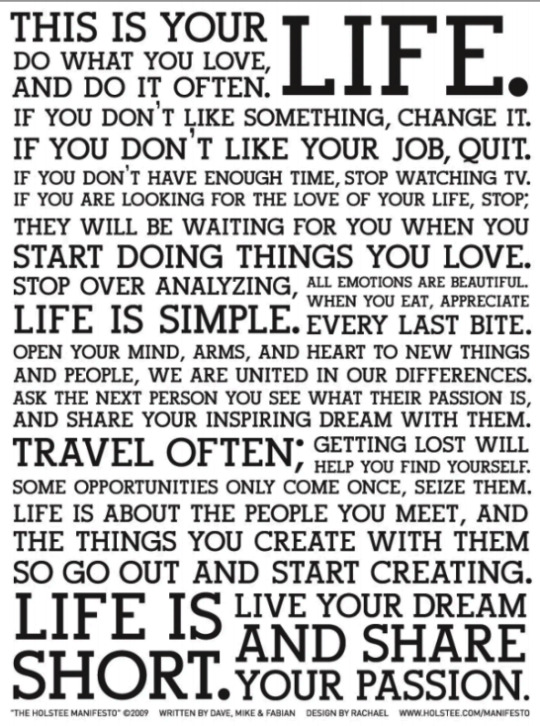
The Holstee Manifesto - Life Cycle
youtube
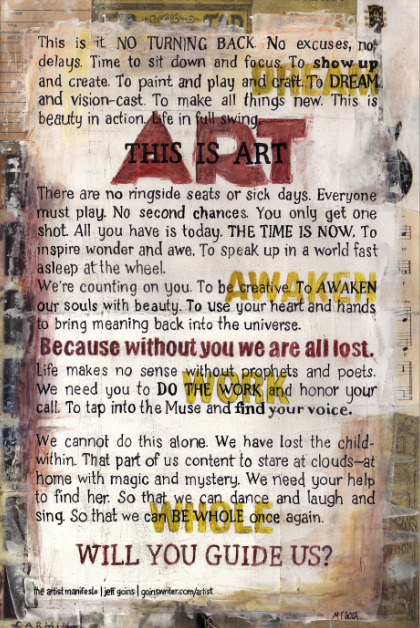


WRITING YOUR OWN MANIFESTO
A manifesto is a declaration of aims and policy
This task asks you to articulate and commit to a statement regarding your work in that arts and its intent
Ask yourself the question, ‘What do you believe?’
0 notes
Photo

_INTERNATIONAL STYLE
1. What happened to modernism when it cross the Atlantic? 2. Were there problems with this goal approach?
America’s lack of history and self-building in terms of art made it look up to Europe’s modernism to try to build its own type of movement. They wanted to build their own culture yet they didn’t have any, considering they are a mix of different ones coming from immigrants that ended up being appropriated together and became American Modernism. However, that’s what they did, they collected elements from all the different cultures that were inserted in their territory and called their mix “American Culture. They also appropriated the European Style to crash it without any preoccupation since that history wasn’t theirs. There was something about the psycho-sexual subject matter, conceptual ideas, and expressive use of bright colors that made Americans wish to experiment more and expose their own style. Also, in the half of the 20th century, fascism and the circumstances of the Second World War made the intellectual society and leading designers (Bauhaus was closed) move from Europe to America, planting their working methods, values, philosophies and ideas in the American territory however with the wish to dispense the old and focus on the modern and how this new industrialized world with its rapid way of living made people be swallowed, becoming alienated, without any purpose in life. There was a lack of identity and people wanted to rediscover themselves and art was included on that. Artists and designers then started to explore techniques, forms and materials that could be the new tools to build a new world, mixing art with practical work. The individual's importance was emphasized as well as the focus on the natural and human sciences. Art was like an escape, almost creating a fantasy and parallel world, that is seeing in so many collages, abstract and mixed medias made in that moment. Consequently, this freedom to experiment lots to make art became product, and that was when publicity was born as a new way of thinking since it embraced art and design with the business world, transforming art into a product that needed to be made then consumed.
0 notes
Text
American Afterlife

David Leo Rice On Steve Erickson’s Shadowbahn
Simultaneous Histories
Shadowbahn, Steve Erickson’s 10th novel, opens with the impossible happening in America: the Twin Towers appear in the heart of the Badlands in South Dakota and Jesse Presley, Elvis’s stillborn twin, wakes up on the 93rd floor of the southern one. Much of the “United States of Disunion,” as the nation is known here, flocks in to bear witness, only to fall into intense disagreement about what has happened and what it means.
Long obsessed with the the fault lines running through the American soul, Erickson has now given us the first key novel of the Trump Era. Written before the election but published after, Shadowbahn is hyper-aware of the ways in which America has not only been split into rival factions, but into mutually exclusive realities. If the old wisdom was that “it’s impossible to be in two places at once,” in 2017 it has become impossible to be in one place at once. All places in Trump’s America, which represents both the End Times and the supposed return of a great mythic past, are frighteningly multiple.
After an opening scene in which a trucker whose truck bears the bumper sticker “SAVE AMERICA FROM ITSELF” discovers the “American Stonehenge” in the Badlands, Shadowbahn only gets stranger as it goes along. Jesse Presley works up the nerve to jump out of the South Tower and finds himself flying into a revised 20th century where JFK lost the Democratic nomination to Adlai Stevenson and the Beatles never took off. Making his way as a cantankerous music critic, Presley meets Andy Warhol and falls into a bizarro version of the Factory scene, commenting on the decline of America from within the novel just as Erickson comments from without. Meanwhile, a brother and sister (one born in California, the other in Ethiopia) drive across near-future America via a series of lost highways and secret tunnels, discussing their fraught relationship with their writer father (a clear Erickson stand-in, carried over from 2012’s These Dreams of You) en route to visit their mother in Michigan. By the time they reach the Badlands and see the Towers for themselves, numerous realities have been born and died and reemerged transfigured, and the map has gotten ever more skewed without quite ceasing to be navigable.
In bringing all these strands together without forcing them to cohere, Shadowbahn marks a culmination of both Erickson’s apocalypticism and his vision of history as a porous entity, full of glitches, wormholes, and “Rupture zones.” Straddling the Millennium, the terms of his ongoing project are most clearly defined by 1989’s Tours of the Black Clock, which charts a simultaneous history in which Hitler far outlives the 1940s, eventually coming to America. That novel—which lent its name to the glorious and now sadly defunct literary journal Black Clock, yet another casualty of 2016—develops the notion of hidden events running parallel to, and occasionally intersecting with, those we’re aware of. The black clock itself is the embodiment of this idea: it’s the “dark back of time” (to borrow a phrase from Javier Marías), ticking with unseen minutes and hours behind those we perceive passing.
Like the black clock, the shadowbahn renders subjective experience objective, making Erickson’s psychic landscape disturbingly physical. Cutting “through the heart of the country from one end to the other with impunity,” it connects disparate times and places the way a jittery radio dial splices together stations.
On the one hand, it’s a dangerous strand of wishful thinking to imagine a simultaneous America in which Donald Trump is not our president, or one in which he turns out to be merely a blowhard and not a tyrant; on the other hand, the election represents a possibly unfixable rift in the fabric of our national consciousness, so that the present we now occupy is both unimaginable and hyperreal—so in-your-face it’s impossible to see.
Not Quite a Surrealist
By charting this process, Erickson’s work bears resemblance to that of sci-fi visionaries like Philip K. Dick, J. G. Ballard, and William Gibson, but he differs from them in that he has a poet’s soul, not a paranoiac’s. Though he makes use of the language and imagery of sci-fi, his simultaneous histories excavate buried layers of how our reality actually is, not alternate paths it could have taken or could one day take.
This is not to say that Erickson’s work isn’t heady, just that its primary theme is heartbreak, not cracks in the matrix. He believes too strongly in the promise of what America could be to give in fully to highbrow cynicism. In this sense, he’s a patriotic writer, one committed to an American promise that’s been broken over and over again without yet ceasing to resonate.
Just as Erickson isn’t exactly a sci-fi writer, he’s not quite a surrealist either. Perhaps in the European surrealism of the early 20th century—Buñuel, Dalí, Magritte—there was a sense that the external world had become too real, and thus that departing from it (or rising above it, in the literal sense of the term sur-real) was a necessary and plausible response. But now, almost a century after Un Chien Andalou, the events around us and their incessant representation online are too bizarre and too ubiquitous to satirize or depart from: everything, in one way or another, is part of the same post-truth morass. If this is the logic that 21st century fascism will exploit, then Erickson’s determination to plunge all the way into the real, deeper than is comfortable, rather than departing from it or offering any reassuring vision of its ultimate unity, has never been more necessary.
Disjunctive Style
Shadowbahn is self-consciously a symptom of the situation it reflects: the style itself (composed of lists, snippets of dialogue, newspaper clippings, and free-floating paragraphs) is as disjointed and hard to navigate as the lost roads its characters drive down. In this regard, Erickson’s authorial logic has a strange resonance with Trump’s: the shared understanding that our American language is one of constant revision and self-contradiction, and that the grotesque distance between the American Dream and its reality only makes that Dream grow stronger. Needless to say, this language holds great potential for both good and evil.
Living in the End Times
Jesse Presley dates America’s lifespan as running from 1776 to 2001, and yet he still exists in America; indeed he exists for the first time long twenty years after the Towers fell. This means that he’s living in an afterlife, along with everyone else in the novel.
Whether one chooses 2001 or 2016 as the year of America’s death, there’s no denying that we’re all sharing that afterlife now. The apocalypse may have come, but here we still are. In this sense, the book's value lies in its exploration of the Times aspect of the End Times. The End, if and when it truly comes, will neither require nor allow for literature (”when you're dead, you're dead,” as they say), but the Times do require interpretation and consideration, more so than ever because their rules are unwritten.
Since life goes on, growing stranger but not yet unlivable, a book like Shadowbahn serves as a bulwark against numbness and the dangerous belief that the only response to incomprehensibility is inaction. Much to the contrary, Erickson argues that even when reality has splintered, it still contains right and wrong and the two remain distinguishable, in art and in life, until enough people stop believing they are.
American Music
Animating these End Times, as in much of Erickson’s work, music is the one source of renewal. Perhaps because it’s an ephemeral, ever-evolving entity, deriving its power from groove and rhythm, not from rhetoric and ideology, music, especially the blues, which was born out of oppression and worked to overcome it, is the one sanctum in which the American Dream can’t be killed. Music streams from the Towers “like the northern lights”—a natural phenomenon that verges on the supernatural—and everyone who flocks to the Badlands hears different songs, from a sheriff nostalgic for the tunes of her youth to an older man hearing Brian Eno for the first time. This too echoes the current multiplicity of news and social media feeds we all curate, plugging into whichever version of reality we find most satisfying or most exciting, and yet, beneath this disjunct, the power of music itself remains singular.
Late in the novel Erickson writes, “At the previous century’s root was a blues sung at the moment when America defiled its own great idea, which was the moment that idea was born.” Throughout Presley’s and the siblings’ long strange trips, blues, rockabilly, and spirituals like “Shenandoah” (which recurs numerous times throughout the book, sometimes with the word “Shadowbahn” set to the same tune) express both yearning for what America could be and outrage at what it’s become.
Further, with many of the novel’s sections organized as annotations to playlists of classic and forgotten songs, and an absent father (the “Supreme Sequencer ensconced on a mountaintop”) communicating with his children through his mp3 collection, Shadowbahn posits music as our only means of straining to hear the voice of God in the new American desert. Maybe, in one simultaneous history, the current moment will revert us not to some whitewashed version of the 1950s, but all the way back to an age of primal wandering among weird monoliths and along unmarked highways, praying for salvation wherever it may be found. And perhaps out of this, a new America, however disfigured and unruly, will begin to grow, one in which we listen not to the punishing voices of the Old Testament patriarchs but to that of Elvis and the blues and whatever musical forms are still to come.
A Future
The possibility of such a regeneration is the only hope Shadowbahn leaves us with. This is a hope for American life going on, and also a hope for Erickson’s continued literary project, which has by now fully processed the psychic fallout of the 20th century and begun in earnest on the 21st, a time when it seems that “wealth and power is the only American idea left.”
Until now, all of Erickson’s novels have been self-referential, a giant interconnected body of work developing alongside the history we all share, deviating from it but always returning to some recognizable baseline of communal fact. Now that history is unraveling, splitting into ever narrower and less internally consistent versions, perhaps a similar unraveling will occur in Erickson’s future work. There’s certainly no American author better suited to embrace the assault on reality we’re now witnessing, and the ways in which history has been jump-started again, after the lull of the Obama years. No longer are we listening to an album we all know; the soundtrack of 2017 is a stranger’s mp3 player set on Shuffle. Given that there’s no longer any stable ground to stand on, the job of serious contemporary fiction is to reflect this instability, not to deny it.
At the very end of the novel, the truck with the “SAVE AMERICA FROM ITSELF” bumper sticker reappears, this time in a ditch beside the highway, its driver having fallen asleep at the wheel. The siblings, after some debate, decide to rescue him. In beginning to consider how such an act of rescue might still be possible on the national scale, one could do far worse than consulting Shadowbahn for inspiration.
David Leo Rice is a writer and animator living in NYC. His stories have appeared in Black Clock, The Collagist, Birkensnake, The Rumpus, Hobart, Volume 1 Brooklyn, and elsewhere. He's online at www.raviddice.com, and his first novel, A Room in Dodge City, is available now.
16 notes
·
View notes
Link
Donald Trump’s overwhelming victory in Tuesday night’s New Hampshire primary makes him, according to both betting markets and many analysts, the favorite to win the Republican nomination. Trump has been written off as an entertainer and circus clown, but he has been tagged with another, much more serious label: fascist. Trump’s campaign has stirred bigoted feelings in the electorate and played to voters’ worst fears and prejudices. And so far, it’s working. Two-thirds of New Hampshire Republicans, according to exit polls, favored Trump’s ban on Muslim immigration.
Isaac Chotiner
Isaac Chotiner is a Slate contributor.
To discuss Trump’s rise and its historical echoes, I called Robert Paxton, a leading authority on the history of fascism. A regular contributor to the New York Review of Books and an expert on Vichy France, Paxton has written numerous books on European history. We discussed the ways in which Trump is and is not a fascist, whether Trump believes what he says, and why now, of all times, so many Americans seem to be embracing him. The conversation has been edited and condensed.
Advertisement
Isaac Chotiner: As a historian of fascism, what do you make of Trump’s rise?
Robert Paxton: Well, it’s astonishing and depressing because he’s totally foreign to any of the skills that are wanted in a president of the United States. What we call him is another matter. There are certainly some echoes of fascism, but there are also very profound differences.
Get Slate in your inbox.
Start with the echoes.
First of all, let me preface it by saying that I’m very, very reluctant to use the word fascism loosely, because it’s almost the most powerful epithet you can use. I guess child molester might be a little more powerful but not much.
Advertisement
Nazi maybe, but that’s just a version of fascism.
It’s the same thing. It’s enormously tempting. Anyway, the echoes you can deal with on two levels. First of all, there are the kinds of themes Trump uses. The use of ethnic stereotypes and exploitation of fear of foreigners is directly out of a fascist’s recipe book. “Making the country great again” sounds exactly like the fascist movements. Concern about national decline, that was one of the most prominent emotional states evoked in fascist discourse, and Trump is using that full-blast, quite illegitimately, because the country isn’t in serious decline, but he’s able to persuade them that it is. That is a fascist stroke. An aggressive foreign policy to arrest the supposed decline. That’s another one. Then, there’s a second level, which is a level of style and technique. He even looks like Mussolini in the way he sticks his lower jaw out, and also the bluster, the skill at sensing the mood of the crowd, the skillful use of media.
I read an absolutely astonishing account of Trump arriving for a political speech, somewhere out West I think, and his audience was gathered in an airplane hangar, and he landed his plane at the field and taxied up to the hangar and got out. That is exactly what they did in 1932 for Hitler’s first election victory. No one had ever seen a candidate arrive by plane before; it was absolutely dazzling, the impression given, the decisiveness of power, of authority, of modernity. I suppose it was accidental, but wow, that is an almost letter-perfect replay of a Hitler election tactic. And the capacity of Trump to enlist working-class voters against the left is exactly what Hitler and Mussolini were able to do. There are definitely echoes.
Introducing Fascism
A new Slate Academy asks what happened in the 20th century—and whether it’s happening again.
Do you think that Trump is consciously using fascist tropes, or do you think that he’s just sort of stumbled into this?
Advertisement
I doubt it’s conscious. I don’t think he’s a bookish man. I’m sure he’s never read a book about Hitler or Mussolini.
He’ll read your books after this interview.
Perhaps.
When people like you and me watch Trump, I think we tend to assume he is a bullshitter who doesn’t have deeply held positions and is acting to a degree.
Advertisement
Yeah.
I think a lot of people would say, Well, Hitler and Mussolini, they believed what they were doing. Fascists generally believe what they’re doing. In fascism, do you think that there was more bullshit and politicking than people assume?
Totally. One of the reasons I wrote my book was that I was so tired of people interpreting fascism as the application of a program. When you read Hitler’s program, his 21 points, when the party was founded in 1920, and when you read Mussolini’s first program in 1919, it had very little to do with what they eventually did. Mussolini, particularly, came from the left, and his first program included things like the vote for women, the abolition of a monarchy. It was more his style than the details of the program. The details of the program were constantly changing. They say whatever seems to suit the mood of the moment. Mein Kampf is taken as a model that [Hitler] carried out—well, in Mein Kampf, he wants to make peace with the British. They are full of inconsistencies, they were very opportunistic, totally opportunistic, and there was a high degree of change in their programs.
Tell me the ways in which you think Trump is not fascist.
Advertisement
I think there are some powerful differences. To start with, in the area of programs, the fascists offer themselves as a remedy for aggressive individualism, which they believed was the source of the defeat of Germany in World War I, and the decline of Italy, the failure of Italy. World War I, the perceived national decline, they blamed on individualism and their solution was to subject the individual to the interests of the community. Trump, and the Republicans generally, and indeed a great swath of American society have celebrated individualism to the absolute total extreme. Trump’s idea and the Republican plan is to lift the burden of regulation from businesses.
That’s fascinating. Anything else?
The other differences are the circumstances in which we live. Germany had been defeated catastrophically in war. Following which was the depression, which was almost as bad in Germany as it was here. Italy was on the brink of civil war in 1919. There were massive occupations of land by frustrated peasants. The actual problems those countries addressed have no parallel to today. We have serious problems, but there’s no objective conditions that come anywhere near the seriousness of what those countries were facing. There was a groundswell of reaction against the existing constitutions and existing regimes. That’s trumped up here; accidental pun, sorry.
Do you think there’s something about this moment in America that makes the country vulnerable to someone like Trump? Because as you noted, it’s hard to say that America is really in a horrible place.
No, this country has the strongest economy in the world and is still the strongest military power in the world without any close rival. The trends are not downward unless you were offended by the presence of a black man in the White House.
There are only millions of Americans that fit into that category.
I’m afraid so. The argument is very clear. Like the argument of Hitler and Mussolini that the existing government is weak, and therefore, we must have a government that is appropriate to the grandeur of America. The portrayal of Obama as weak, which is astonishing considering the degree to which Obama has used military power.
Nevertheless, a lot of people are left behind in the recovery. Poorly educated white males are left behind, and the country is not better for them, and there are enough of those people to make a huge difference. I don’t think there are enough of those people to elect a president, but they can make a powerful movement.
Again, I’m obviously not comparing Trump to Hitler as a person, but watching the “moderate” Republicans tear each other apart over the last few weeks and then split the vote five ways in New Hampshire last night, I thought of the 1932 election in Germany, with everyone kind of thinking, depending on their interests, that there were bigger threats than Hitler and not focusing on him until it was too late.
2 notes
·
View notes
Text
*Burke: Rhetoric As Division*
Video link: https://www.youtube.com/watch?v=BfJ25LXtLTg
Prager University? More Like Prager Unification Device
The critical question that I will be exploring in this post is: “How is Burke’s notion of the unification device evident in this artifact? How are each of the components at play? How is this productive and/or unproductive (ethical/unethical) for society?
The artifact that I will be examining for this question is a recent video entitled “Why You Should Be A Nationalist” uploaded by the YouTube channel PragerU. PragerU, short for Prager University, is a non-accredited conservative-leaning nonprofit group. The mission statement of Prager University, which, it should be mentioned, says it is ��not a university” on the frequently asked questions page of its website, is to create 5-minute educational videos that cover issues that are “important to understanding American values” (PragerU 1). This includes, primarily, politics, history, culture, and economics, all with the angle of a belief in: “economic and religious freedom, a strong military that protects our allies and the religious values that inform Western civilization, also known as Judeo-Christian values” (PragerU 1).
This video in particular is focused on the topic of nationalism and the supposed bad rap the ideology has recently received. In the video, Yoram Harzony, a scholar of Jewish theology and philosophy, shares several points from his book “The Virtue of Nationalism”. In essence, he argues that nationalism means true personal freedom, while globalism, which is grouped with fascism, imperialism, and transnationalism, means the forcing of an ideology upon the entire world. In making this argument, Harzony makes constant use of Burke’s notion of the unification device. He creates a vision of inborn dignity by associating respected historical figures with nationalism, uses the projection device of an impending globalist threat, promises a symbolic rebirth by asserting that nationalism has long been dormant, and makes the whole thing viable for commercial use by packaging it with slick graphics in a video essay format. The components all make themselves increasingly clear as his arguments develop, in a result that is unproductive for society as a whole, due to its simplification of opposing views and demonization of continued dialogue.
Burke describes the qualities of inborn dignity as: “[a] categorical dignity is considered to be the attribute of all men” in reference to the religious ideals of humans as above other living things (Burke 193). Burke also points out that this inborn dignity can be twisted to apply to any two opposing groups, his example being the inborn dignity that Hitler attributes to the German, over the Jewish, people. As soon as the video begins, Harzony begins to bestow an inborn dignity to nationalism, implying its inherent superiority over opposing ideologies. Harzony does this by tying nationalism to respected historical figures. These include Ronald Reagan, Margaret Thatcher, and Mahatma Gandhi, historically significant names that their target audience most likely respect at the very least. In tying nationalism to these figures from the past, Harzony is implying a previously existing dignity in nationalism, making nationalism a standard to adhere to. Elsewhere in the video, Harzony argues that human nature is to prioritize loyalty to family, tribe, and nation, calling this nature the “key to human freedom”. In arguing that nationalism is just the natural state of humans, Harzony furthers the concept of nationalism possessing an inborn dignity. In these two moves, Harzony both paints nationalism as something admirable and asserts that it is a natural law. As a final addition, Harzony claims the Bible extolls the virtues of nationalism. He references God creating borders for the Israelites, saying: “Borders are in the Bible and are where you should stop” (PragerU). This functions as an additional appeal to authority, as well as appealing to the Bible for validation of the inborn dignity. The result is a perfect example of Burke’s inborn dignity created around an ideological group.
The pivot to the use of Burke’s projection device begins when Harzony begins to employ scare tactics. Burke describes the use of the projection device as: “the ‘curative’ process that comes with the ability to hand over one’s ills to a scapegoat” (Burke 193). Harzony creates a scapegoat in globalists. Harzony argues that the only alternative to a nationalistic world is a one-world globalist order, in which all nations are brought into line at gunpoint. By his reasoning, the only control a globalist system could exert is force. Harzony also lumps together globalism with imperialism and communism. He also asserts that the Nazis are misunderstood as nationalists and actually were, in fact, imperialists. This creates a dichotomy in which nationalism is a misunderstood, slandered ideal, and opposing viewpoints are supposedly in line with some of the most oppressive regimes to exist in the 20th century. Furthermore, Harzony paints nationalism as an oppressed ideal in itself. He argues that the nationalists in America are referred to as “Deplorables”, unifying them as a supposedly oppressed group. He then argues that, following the World Wars, a reactionary world pined for the simpler narrative of a global community to avoid tragedies like those that had occurred. Because of this reaction, Harzony says that the creation of the United Nations, the European Union, and a global move to a less nationalistic view oppressed nationalism for nearly half a century. Harzony even describes the Earth before the World Wars as a “better, freer world for 300 years” (PragerU). This conveniently allows for any current societal ills to be blamed on this long stint of globalist views, solidifies globalists as the projection device, and prepares the audience nicely for the device’s next element.
In general, the message created here is unproductive for society. In using the unification device, it continues to encourage “us vs. them” dichotomies and misleading rhetoric, pushing further away from any goal that involves mutual understanding between competing ideologies. The ignorance of a goal of understanding creates a scenario in which one ideology must be dominant and wipe out competing ideologies. This is a scenario Kenneth Burke was hoping to help society at large avoid in identifying Hitler’s use of the unification device in the first place. The place that Prager U’s brand of nationalism leads is a discordant one, but the utilization of the device is allowing it to be presented as the only possible solution for the problems of the common citizen.
Harzony then moves to the final unification device elements of symbolic rebirth and commercial use, combined here because they don’t quite saturate the video as much as the first two. Burke argues that, in combining the first two elements, “they can again get the feeling of moving forward, towards a goal” (Burke 194). As the video ends, Harzony says: “Nationalism is having a resurgence. If you care about freedom, you should hope it succeeds” (PragerU). What Harzony is promising here is Burke’s symbolic rebirth exactly. He is implying that with a resurgence of nationalism onto a global stage, society’s ills, caused by the ruling globalist ideology, will be fixed. Additionally, this entire message is packaged in a way that gels with Burke’s final notion of the unification device, commercial use. Essentially, Burke argues that the unification device is packaged to sell the ideology. Harzony’s message is packaged with cute animated graphics, a video-essay style that is currently popular on Youtube, and the “University” in the channels name, all elements that will make the video palatable to the average viewer that may stumble upon it. In all these ways, this video embodies the idea of the unification device.
Jason Thompson, in his paper “Magic for a People Trained in Pragmatism: Kenneth Burke, Mein Kampf, and the Early 9/11 Oratory of George W. Bush.”, applies Burke’s unification device to the post-9/11 rhetoric of George W. Bush similarly to my own application of the device to PragerU’s video in this analysis. In Thompson’s words: “George W. Bush, who also had 'crude magic,' used the Hitlerian rhetoric of a common enemy and a geographic center in order to realign post 9/11 attitudes” (Thompson 1). There are clear parallels that can be drawn between George W. Bush’s strategies presented here and the creation of a common enemy, appeals to nationalism, and attempted unification present within the PragerU video. Comparisons like these make it clear that Burke’s unification device isn’t just still used, it’s used frequently. As stated elsewhere in Josef Schmidt’s “In Praise of Kenneth Burke: His "The Rhetoric of Hitler's'Battle'" Revisited”: “Kenneth Burke closes his review of ‘The Battle’ by returning to his own pragmatic context, namely that ‘Hitlerite distortions of religion apparent’ not be used by American politicians ‘to perform a similar swindle’” (Schmidt 6). Between the device’s appearance in the analyzed video and its presence in other scholarly analysis of political speech, it’s clear that Burke may have been correct in his worry, we should be vigilant of a “similar swindle”.
In conclusion, Prager U’s video “Why You Should Be A Nationalist” uses Burke’s unification device by creating an inborn dignity in nationalism, making globalists a common enemy, promising a symbolic rebirth in the new dawn of nationalism, and packaging it all in a commercially consumable video. It works against progress in society by sowing division and moving further from mutual understanding. The way to progress is a society that’s more critical of messages that come from pragmatic institutions like Prager U and a sharper public eye that can spot what Burke had warned us about.
Citations
Burke, Kenneth. “The Rhetoric of Hitler's Battle.” Readings in Rhetorical Criticism, by Carl R. Burgchardt, 3rd ed., Strata Publ., 2005, pp. 188–201.
PragerU, director. Why You Should Be A Nationalist. YouTube, YouTube, 17 Dec. 2018, www.youtube.com/watch?v=BfJ25LXtLTg.
Schmidt, Josef. “In Praise of Kenneth Burke: His ‘The Rhetoric of Hitler’s “Battle”’ Revisited.” Rhetor. Journal of the Canadian Society for the Study of Rhetoric, vol. 1, Jan. 2004, pp. 1–7. EBSCOhost,search.ebscohost.com/login.aspx?direct=true&db=ufh&AN=103101821&site=ehost-live.
Thompson, Jason. “Magic for a People Trained in Pragmatism: Kenneth Burke, Mein Kampf, and the Early 9/11 Oratory of George W. Bush.” Rhetoric Review, vol. 30, no. 4, Oct. 2011, pp. 350–371. EBSCOhost, doi:10.1080/07350198.2011.604608.
0 notes
Link
The legendary Maly Drama Theatre of St. Petersburg – described by Peter Brook as ‘the finest ensemble theatre in Europe’ – returns to London this spring for a strictly limited engagement for the first time in over a decade. They will present the UK première of Vasily Grossman’s epic novel, Life and Fate, and reprise their celebrated production of Anton Chekhov’s Uncle Vanya at London’s Theatre Royal Haymarket. Press nights will be held for Life and Fate on Tuesday May 8th and Wednesday 9th and on Tuesday May 15th for Uncle Vanya. Both productions will be performed in Russian with English surtitles.
Under the artistic directorship of Lev Dodin – one of the most celebrated theatre practitioners working today – the Maly Drama Theatre of St. Petersburg has become one of the greatest theatres in the world. During his 35 year tenure many of Dodin’s shows have won international awards including state prizes of Russian and the USSR, Golden Mask Awards and a Lawrence Olivier Award (becoming the first international company to do so for Stars in the Morning Sky, 1989). In 2000 he received the European Theatre Award.
LIFE AND FATE (UK PREMIÈRE) 7.00pm May 8th & 9th (Press Nights), 11th, 12th, 18th, 19th – 2.30pm May 20th “Big, frightening, merciless yet incredibly touching, tortured and beautiful… a requiem of a performance.” Kommersant, Moscow
It’s early 1943. Hitler’s Germany and Stalin’s Russia are in a bitter struggle for their very survival. Adapted for the stage for the very first time from Vasily Grossman’s celebrated novel, banned because of the parallels it drew between Nazism and Soviet Communism, Life and Fate is a sweeping panorama of Soviet Society, an epic tale of a country told through the fate of a single Jewish family, the Shtrum’s.
From Nazi concentration camps to the Gulags of Siberia and the Soviet nuclear programme, as the battle of Stalingrad looms large the characters must work out their destinies in a world torn by ideological tyranny and war.
This critically acclaimed production, winner of the Golden Mask for best play, has toured around the world since its première in 2007, shining a light on the heart of 20th-century darkness.
On presenting a draft prior to publication, Grossman’s magnum opus, Life and Fate, was seized by the KGB. The former Red Army newspaper war correspondent, (championed by his fellow soldiers for the honesty of his writing) was told by the Communist Party’s chief ideologist Mikhail Suslov that the novel would be unpublishable for at least 200 years. Its astonishing act of wartime truth-telling and the parallels it drew between the Soviet Union and the Third Reich were deemed unacceptably anti-Soviet. Grossman became in effect a persona non grata.
The KGB raided Grossman’s flat and seized manuscripts, notes and even the ribbon from the typewriter on which the text had been written. Unbeknownst to authorities, Grossman had smuggled two copies to acquaintances in the literary world. He died in poverty, forgotten and ignored in 1964, but his masterpiece would live on. Microfilmed and smuggled to the West, it was first published in 1980 to critical acclaim. France’s Le Monde hailed it ‘the greatest Russian novel of the 20th Century.’ Military historian Antony Beevor described it as the War and Peace of the Stalinist era.
Lev Dodin discovered the novel in 1985 whilst guest directing in Helsinki. He says: “I still remember vividly that I ‘gulped down’ the novel in two nights and that I was in absolute shock. I didn’t even think before reading it was possible to write about our life in such a way.” Before its world première in Paris in spring 2007 the company spent three years rehearsing the piece, researching the period in great detail, visiting Auschwitz, and eventually premiering the piece in Norilsk, a city in the very heart of Gulag territory.
Dodin continues: “Grossman’s Life and Fate is in fact a simple family story, and it presents us with a vast panorama of the events and problems of the 20th and 21st centuries. In our everyday lives we still encounter the modern guises of fascism, communism, nationalism, totalitarianism, extremism, cruelty and lack of freedom. In spite of everything, people still continue to live, love and hope.
“Suffering has no nationality – I think this is why Grossman’s novel is becoming so popular – again – in Europe and across the world.”
UNCLE VANYA 7.00pm May 15TH (Press Night), 16th and 17th Vanya, together with his niece Sonya, has sacrificed his life managing the estate of Professor Serebryakov, his former brother-in-law and Sonya’s father. But when the Professor returns from the city with his glamorous young wife Yelena, tensions spiral as their world is thrown upside down.
Chekhov’s tragicomic masterpiece of dashed dreams and thwarted and eternal love returns to London in Lev Dodin’s definitive interpretation of this classic play.
Maly Drama Theatre of St. Petersburg’s Royal Theatre, Haymarket season is presented by Oliver King and Ekaterina Kashyntseva for Belka Productions with the support of Roman Abramovich, Sir Leonard Blavatnik , Yuri Shefler & Alexander Machkevitch.
For more information visit Maly2018.com. Follow on Twitter #Maly2018
MALY DRAMA THEATRE OF ST. PETERSBURG
LONDON 2018 SEASON LISTINGS Theatre Royal Haymarket, Haymarket, London, SW1Y 4HT
LIFE AND FATE Tue 8th May – 7.00pm Wed 9th May – 7.00pm Fri 11th May – 7.00pm Sat 12th May – 7.00pm Fri 18th May – 7.00pm Sat 19th May – 7.00pm Sun 20th May – 2.30pm
UNCLE VANYA Tue 15th May – 7.00pm Wed 16th May – 7.00pm Thur 17th May – 7.00pm
http://ift.tt/2mNEMrq London Theatre 1
0 notes
Link
Artist: William E. Jones
Venue: David Kordansky, Los Angeles
Date: July 15 – August 26, 2017
Click here to view slideshow
Full gallery of images, press release and link available after the jump.
Images:
Images courtesy of David Kordansky, Los Angeles. Photos by Lee Thompson.
Press Release:
David Kordansky Gallery is pleased to announce an exhibition of new work by William E. Jones. The exhibition will feature a major new video, Fall into Ruin, in which the artist gives a personal account of the life, home, and collection of Greek art dealer Alexander Iolas. It will also include a series of still photographs of Iolas’s villa taken by Jones on the occasion of his first trip to Greece in 1982.
For over three decades William E. Jones has been producing films, videos, photographs, and books that re-examine and repurpose existing cultural materials. While some of his sources are images and texts housed in archives, he is equally at home out in the world taking pictures and conducting interviews. He has explored the decline of America’s industrial Midwest, the representation of gay men in sources as diverse as Eastern European pornography and police surveillance footage, the psychedelic visual potential of Cold War military footage, and poetic connections between the randomized nature of the Internet and ancient philosophy.
Fall into Ruin consists of a sequence of still images taken during visits Jones made to Greece in 1982 and 2016. These images depict the home and art collection of Alexander Iolas (1907-1987), a gay, Egyptian-born former dancer who was one of the 20th century’s most iconic art dealers, as well as scenes of present-day Athens and images of antiquities on view at the National Archaeological Museum. In an essayistic voice-over, Jones tells the story of his connection to Iolas and reflects upon the circumstances resulting in the villa’s ruin. Equal parts memoir, celebration, and lament, the video examines the value systems that made Iolas’s rarefied milieu possible and those that eventually allowed it to fall apart.
Perhaps best known as a dealer specializing in work by the Surrealists, and for his work in shaping the collection of John and Dominique de Menil, Iolas also represented major 20th century artists like Yves Klein and Paul Thek, and gave Andy Warhol his first solo exhibition. He was an international figure who spoke several languages (his galleries were located in New York, Paris, Milan, Geneva, Madrid, and Athens) and he moved with ease in a variety of social settings. “Villa Iolas,” as his Greek home was affectionately called, was a place where he could display artworks as well as host a rotating cast of eccentric characters. Jones’s pictures of the house in its heyday prompt recollections of a time when the art world privileged intimacy and personal contact. They also serve as opportunities to reflect on the committed relationships Iolas fostered with his artists, treating them as others might treat friends or even family, and his willingness to support them financially and emotionally when they fell upon hard times.
Iolas’s own collection, filled with antiquities and furniture in addition to works by the modernist masters he showed, was the product of a wide-ranging and highly personal sensibility. Objects made thousands of years apart were often installed side-by-side. Seeing this as a young man traveling abroad for the first time, Jones discovers a vital link to the ancient past and a reminder that the classical tradition is not a monolithic phenomenon but rather a messy, living, evolving force in which he too can play a part
Jones invokes a parallel example in the figure of the poet C.P. Cavafy (1863-1933), who re-imagined scenes and characters from the past in a modern, frankly sexual idiom; like Iolas, Cavafy was a gay Greek man from Egypt who embodied an era of cosmopolitanism already on the wane. The video’s images of classical sculpture in a contemporary museum setting reinforce the fact that cultural memory is always subject to revision.
Jones further erodes any sense of easy nostalgia with images of the villa in its current dilapidated state, and of an Athens beset by problems associated with global capitalism. This juxtaposition underscores the profound changes that have taken place during the 34 years that separated his two trips to Greece. While these would seem to be cause for despair, the details of Iolas’s life offer a kind of melancholy hope, as he managed to thrive even when faced with geopolitical problems beyond his control (including fascism and financial collapse), problems that continue to reverberate today.
The still photographs on view were taken by Jones in 1982 but only printed and exhibited for the first time this year. Returning to them now becomes not only an occasion to revisit his memories of Iolas, but to revel in the lavish idiosyncrasy of the dealer’s approach to art and design. Paintings, sculptures, flowers, books, and furniture function in these works as if they were sentient beings posing for the camera. The pictures are more than documents of a time and place. They bring objects and spaces alive, reawakening a timelessness that can go dormant, but never die.
William E. Jones (b. 1962, Canton, Ohio) has been the subject of many solo exhibitions and retrospectives at institutions, including the Wexner Center for the Arts, Columbus, Ohio (2015); Saint Louis Art Museum, Missouri (2013); Austrian Film Museum, Vienna (2011); Anthology Film Archives, New York (2010); and ar/ge kunst Galerie Museum, Bolzano, Italy (2009). Recent group exhibitions include Remastered -The Art of Appropriation, Kunsthalle Krems, Donau, Austria (2017); IHME Contemporary Art Festival, Helsinki (2017); On Limits: Estrangement in the Everyday, The Kitchen, New York (2016); Ordinary Pictures, Walker Art Center, Minneapolis (2016); Les Rencontres de la Photographie, Arles, France (2015); The Heart Is the Frame, Los Angeles Contemporary Exhibitions (2015); In __ We Trust: Art and Money, Columbus Museum of Art, Ohio (2014); Elements of Architecture, 14th International Architecture Exhibition, Venice, Italy (2014); and The Past Is Present, Museum of Contemporary Art Detroit (2013). Jones lives and works in Los Angeles.
Link: William E. Jones at David Kordansky
Contemporary Art Daily is produced by Contemporary Art Group, a not-for-profit organization. We rely on our audience to help fund the publication of exhibitions that show up in this RSS feed. Please consider supporting us by making a donation today.
from Contemporary Art Daily http://ift.tt/2wjYj93
0 notes
Text
( IDEX Online ) - July 30, 1914, 100 years ago, in the smoke-filled negotiation rooms and government offices, two completely different kinds of negotiations were held: one to prevent the outbreak of the First World War, and others to prevent the threat of the collapse of the diamond world. The first negotiations are well documented; With the latter, it is much more difficult, and I often wondered if the governments of the diamond-producing countries were aware of the enormous importance of the consequences of their actions at that time.
Let's look at the parallel events taking place on this fateful day on July 30, 1914, and in the weekend that followed. As historians write, in the morning and all day emperors from all over the world, ambassadors, prime ministers and politicians exchanged proposals, guarantees, assurances and threats. Late in the evening of this day, an order was issued in Russia on military "mobilization". This immediately changed plans around the world, as efforts were shifted from an attempt to prevent the transition of the Austrian-Serbian conflict into a worldwide war to prepare for it, which actually began on Sunday.
By 1918, these four belligerent European empires were completely destroyed; 15-20 million people were killed; The issues that turned the conflict on the Balkan Peninsula into a world war ceased to matter; And the growth of communism and fascism have become more important issues for the surviving members of the alliance than the challenges that they thought to fight before the war.
Historians at the Washington Analytical Center (Progressive Economy) recently suggested that, now, a century later, "this event and its consequences are still puzzling questions of a political and human nature: the reasons why diplomacy and deterrence are not Can help in a crisis situation; The relationship between abstract politics and tactical decisions of governments and military commanders, public sentiment and the experience of ordinary soldiers; First of all, unforeseen consequences of the conflict ".
The years of development of the diamond industry
All these issues of a political and human nature also prevailed during the years of diamond mining and marketing of diamonds. In the early 20th century, South Africa used what is called a "natural monopoly" for the production of diamonds. At that time there were competing mines and the London "syndicate", consisting of independent distributors, which was engaged in acquiring quotas from some individual mines.
In the early 1900s, about 98 percent of all diamonds came from the same geographical location and from one country. This situation changed in 1908, when alluvial deposits of diamonds were discovered in the arid sands of the desert of South-West Africa (now called Namibia). In 1894, the German Chancellor Bismarck (Bismarck) declared this vast territory as a German protectorate, subjugating the Hottentots and other tribes.
In those days, De Beers showed little interest in mining alluvial diamonds, believing that the long-term perspective belongs to mining at great depths. The diamond company simply underestimated the threat posed by the extraction of alluvial diamonds. The American recession in 1907 slowed down the world trade in diamonds; De Beers mines (which were only one of the diamond producers at that time) were actually closed, production was curtailed, inventories increased, and personnel were dismissed. These were pre-war days. One historian writes: "De Beers and Diamond Syndicate did not care about the alluvial deposits of South West Africa. The directors of De Beers, firmly committed to mining at great depths, remained adamant and, like most older people, conservative in their approaches. De Beers has become a "very stagnant organization."
The inability of De Beers to seriously aim at gaining control over these deposits in South West Africa proved to be a historical mistake. Soon, 15 small companies already produced prey on the coastal strip about 100 kilometers after receiving concessions from the Colonial Gesellschaft, which in turn was financed by the German diamond association Deutsche Diamanten Gesellschaft, which fully owned all mining rights for the A special agreement with the German colonial administration. [There were only two concessions "owned by foreigners"].
The Germans quickly adopted the system of selling the London syndicate. In 1900, a controlling body was created, called Regie (management), which was responsible for selling the entire volume of diamond production. Regie walked around London and sold most of its products to the Antwerp syndicate and through him, with whom he had contractual relations. [When some of the diamonds were tendered, Antwerp almost every time offered a higher price than the London syndicate, at least until 1913]. Antwerp dealers managed to almost double the prices in these prewar days.
"Hostile relations" among competing mines
Most of us grew up in an environment where there were diamond cartels that claimed extremely "gentlemanly" manners in relations among cartel members and even in competition with so-called "third-party" producers. Recognizing and realizing mutual interests, or calling it economic interdependence, has never left producers. But this was not the situation in the days before 1914 in the then still limited community of producers. Just to clarify the question, in 1913, the volume of production of rough diamonds in the world amounted to a total of 6.7 million carats worth £ 12 million in 1913 prices. Over 44 percent of them were considered purely technical diamonds. In 1914, after five months of war, production fell to 5.4 million carats. [Using computational tables to determine purchasing power, by which you can say what you can buy today at £ 12 million at 1913 prices, that's equivalent to £ 941.5 million or $ 1.59 billion, so almost 10 percent of the current world volume Production. In value per carat, again using computational tables to determine purchasing power, the values were then $ 237 per carat in the current value expression.] See https://weddingpearlneecklace.tumblr.com/
Let us return to the past. In 1913, in South Africa, De Beers operated four mines, the total production of which was about 2.2 million carats. The competing Premier in the same year also gave 2, 2 million carats, although soon its production fell to below 1 million due to depletion of its resources. The Premier did not want to artificially cut production. De Beers did not like this at all. The following information gives some understanding of the relationship among these diamond mining companies:
"The quarrels between De Beers and Premier did not fade, each side cast another stream of anger and criticism. The Premier's chairman of the board referred to "the attacks regularly and constantly committed by these high-ranking clergymen of the diamond religion: Tashi Lama of Jagersfontein and Dalai Lama of Kimberly ... All I can say is that neither the remarks of the chairman of the board of De Beers, Neither the statements of the chairman of the board of Jagersfontein company will force to reduce the production volume of this company by a single carat
0 notes
Link
"Compulsive liars shouldn’t frighten you. They can harm no one, if no one listens to them. Compulsive believers, on the other hand: they should terrify you. Believers are the liars’ enablers. Their votes give the demagogue his power. Their trust turns the charlatan into the president. Their credulity ensures that the propaganda of half-calculating and half-mad fanatics has the power to change the world. [..] The street violence that brought fascists to power in Italy and Germany and the communists to power in Russia is absent today. The 21st-century’s model for a strongman is a leader who makes opposition as hard as possible, as Orbán is trying to do in Hungary, but does not actually declare a dictatorship, for not even Putin has done that. To my mind, that does not make comparisons with the past fruitless, particularly in the case of the nihilistic and voraciously aggressive Trump. There are very few new ideas in politics. Parallels always illuminate. [..] fascistic style; a fascism with a wink in its eye and a bad-boy smirk on its face. Conventional politicians and commentators are stranded because they were wholly unprepared for the new breed of leader who lies as a matter of policy as well as a matter of course. [..] Comparisons with 20th-century totalitarianism are not wholly exaggerated. With Trump, the lies are a dictatorial assertion of his will to power. “I am in control,” he says, in effect, as he conjures imaginary crowds at his inauguration or invents millions of illegal voters so he can pretend he won the popular vote. “You may know I am lying. But if you contradict me, I will make you pay.” [..] Truth, reason, evidence, decency must all be sacrificed to the greater good of keeping the strongman looking strong. The weapons 21st-century technology provide for political warfare make me doubt that stopping Trump and his imitators will be easy. Just as Britain’s isolated Brexit government has no choice but to compulsively believe that Trump’s pragmatism will overwhelm his extremism, so Americans must hope that the checks and balances of the constitution will cage him. No one can see the future and both may be right. But, as I said, there is no evidence that they are. One reason for pessimism is that Trump’s character may make him worthless as a man but a success as a politician in our time of cyber-charlatanism. [..] The old wisdom was to apologise if you were in the wrong and move the conversation on with as much speed as you could manage. “If you’re explaining, you’re losing,” Ronald Reagan said, as he stated the commonsensical proposition that politicians should not dwell on their embarrassments. [..] Trump understood that Twitter, Facebook and 24/7 news had changed the world. The modern chancer needed to stay with the scandal and arm his supporters with instant explanations. The Trump campaign would not apologise. When caught in a scandal, it doubled down within minutes. It knew its supporters wouldn’t care if the experts they despised as thoroughly as Michael Gove dismissed Trump’s explanations for refusing to release his tax returns or feminists said his advocacy of sexual assaults was something more than “locker-room talk”. “The point is,” Klain said, “Trump supporters were armed with an explanation that they accepted and could use to defend their candidate” on social media. The same need to instil a party line and protect his supporters from reasonable doubt leads Trump and his sidekicks once again to imitate dictators and attack the whole of the free press. Not just opposition journalists, mark you, but the entire media. The reasoning is obvious. Every one of the many financial and political scandals Trump will surely generate will emerge in the media. Every media organisation must therefore be branded as lying and fake before they publish. Journalists need to learn, if they have not learned already, that no accommodation is possible with the alt-right because its ideology and tactics preclude it from wanting an accommodation. You cannot “balance” or appease such people – you can only expose them. [..] Bannon exemplifies the Nazi jurist Carl Schmitt’s sinister ideal of a political leader who unites his supporters by creating enemies for them to hate. Bannon and the alt-right have made Islam – not al-Qaeda, Islamic State, or the Shia theocrats in Tehran but all Muslims – their enemy of choice. They unite their supporters on racial lines against blacks, Jews and Latinos too. As a former journalist on his Breitbart site explained, Bannon believes “in a nutshell that western culture is inseparable from European ethnicity”. [..] It could all go wrong. Trump, Bannon, Farage and the Tory right want to polarise societies. [..] Understand the logic of polarisation and you will understand that Trump wants a violent reaction. He wants to be able to tell white Americans that his opponents are “professional anarchists”, as he said last week. He wants liberals to treat all his supporters as if they are as debased as he is."
0 notes
Text
Week 2 of Drumpf: Believe Me: The Last Thing We Need is Trump to Drop Dead from Natural Causes
Typically the Republican Party, the GOP, the Conservatives of this country propound the preservation and importance of religion. This last election was unique in that both parties--the religious right and liberal (sometime secular) left perceived the candidates on the poles of good and evil. Thus, the failure of the Democratic party and many Clinton supporters was not just an election, but the victory of evil over good. The question of civil society and civil rights is the domain of the liberal left, but why is the fight against Trump being framed as a right/wrong, good/bad concern?
What are the dangers of viewing politics on a good/evil axis? I think it’s useful to look at two dissenting voices from the left of center and right of center to see how nimble the debate around Trump policies can be, whether seeing them as ethical or judicious makes sense strategically.
A recent email exchange between Noam Chomsky and Sam Harris can serve as an example of how framing something in the context of good and bad (via good and evil, see Nietzsche “Beyond Good & Evil) can predetermine the sorts of answers that appear to force a concession of one moral value for another. (I didn’t follow the entire stunt of email bating/debating with Chomsky, but the entire discussion seemed to inappropriately concede to Harris’ desired framework, which is a binary between Western values and “non-Western values.” I should stipulate that I actually haven’t read any of the books, in their entirety, that these two authors have produced pertaining to politics. On one hand the dispute between them is an exchange of both referring the other to a book the former wrote, on the other hand the exchange comes off as a PR stunt on behalf of Harris to garner more attention to his platform from Chomsky fans and/but on a third, prosthetic hand that forces the hands of both of the other hands, and on which I’m qualifying my admitted lack of reading either of their books, both have an excess of non-literate media sharing their political perspectives, media that has communicated in the very least that it isn’t necessary to read their books because, if this media is purposeful, effective, and functional, it (the media--interviews, podcasts, speeches, et al.) can disseminate their political perspectives at least as sufficiently as their books. )
A Generalization of Chomsky & Harris Perspectives on American Foreign Policy as It Pertains to the Point of Trump Dropping Dead by Natural Causes
Noam Chomsky’s critique of American foreign policy is that it’s imperialistic. We uproot dissent in foreign countries through covert CIA and/or overt military operations for the goals of imperialist domination and subsequently economic benefit. The banner under which the U.S. government declares its violence against other people--Terrorism, Freedom, Democracy--as part of the manufacturing of the domestic population’s consent, may change but the motivation is constant. The inaccurate rhetoric of American foreign policy is found not only in the inconsistency of how these banner themes are applied across the globe--i.e. some Muslim countries being our enemies while other being our allies--but also in how our own country does not adhere to its own rallying dogma. While U.S. politicians wage war in the name of Democracy, the same politicians may be countering democratic processes at home. Chomsky’s repeated references abroad are to the CIA interventions in Nicaragua, military support of the genocide of East Timor by Indonesia, the invasion of Iraq under the guise of Weapons of Mass Destruction, and World War II.
Sam Harris’ stance on U.S. foreign policy is that it’s the U.S.’s duty to police the world, to protect civil society and this can and may and at times must be done through militarization and tough love (i.e. secret missions, assassinations, et al.). To secure civil society, we must fight against those who oppose it, e.g. Putin. Because there are regimes that do not recognize human rights, its the duty of HR proponents to fight against the tyranny of the opposition in order to affirm women’s rights, create secular governance and end dictatorships. In the debate with Chomsky he emphasizes the “good intention” of the American foreign policy. His references abroad are much narrower than Noam’s, focusing on the Middle East and Russia since the Cold War until the present.
Harris’ argument is pretty close to Samuel Huntington’s “Clash of Civilizations,” which was the popular framework around the 9/11, Iraq War. It’s a world picture that appealed to George W. Bush. We, the West (Western Europe & North America), are culturally incompatible with the non-West, but really they mean Islam. Asia’s fine. They make our stuff. This clarification is the first of many. It’s not just Islam, but Middle East, and just Middle Eat but Iran, Iraq, Syria, Turkey, Egypt at times...who else...Yemen? Ok, it’s ad hoc. They could have said, “They’re in our way to drive to Kazakstan and must be destroyed,” and it would have been more accurate. You’ll notice, this is the basic road map for Trump’s “Muslim travel ban,” and it’s echoed by many European nationalists. But before I get to how this doesn’t float as a logical argument, I want to return to the fantasy of some good grace shining upon North America, just below the 48th parallel.
Trump & the Grim Reaper
Ok, so with the context of these two interpretations--Chomsky & Harris--‘twer Trump to drop dead, flat out on the floor of the oval office, not resting but stone dead, deceased of natural causes the entire opposition, the rational center, the apprehensive Michiganders that cast no Presidential vote, the Left and Ultraleft would have no other alternative but to revive the idea and belief of Divine Intervention. There would be no room for secular belief. It would simply not be tenable to have the electoral college hand to leave this flaming paper bag on our doorstep and then, suddenly, not have to deal with it. It would be none other than “miraculous.” Thus, both the right and left in the U.S. would collide in religious fervor. The discord of U.S. politics since the mid 20th Century would simply evaporate, having reached a boiling point with in an orange burst of 5th Avenue egocentricity of smoke and mirrors. You think I’m kidding, but there would be no protection for civil society through/on the grounds of secular or non-belief; there would be only “believers.” Civil society would equate to Christian society in the U.S. The conservative right would simply continue their born-againing, and the left, well, they would born again also. The illogic would be...illogical. Here’s how.
The claim that defending Muslims or Islam in America or the rest of the world by the liberal left while aspiring to secularism, human rights and equality, or at least separation of church and state, is contradictory, according to Harris. (More than Chomsky Harris engages in debate with the religious and spiritual communities as part of the New Atheist movement.) But first and foremost, this is a stereotype about any religious society, not just Islam. What about Buddhists? Are Confucians ‘ok’? Second, to view a society solely by their religious makeup is anti-intellectual, as it discards any other valuable assets of that society. I watched the first Sean Hannity interview with Trump, you know, the one where Sean basically tricks the old fart into agreeing to pardon some people he knows, and what’s more interesting than any of that hour rehearsed interview is that a youtube commercial by the Islamic society directly followed the video. It correctly explained the many contributions to the world that Islam has made. For example, the idea of zero. Where would be without zeros? But the point is that any society, regardless of their origin stories, afterlife beliefs or distinctions between “science” and “religion” (this is a Western distinction, BTW. See ‘China’) have great contributions to the world, knowledge, food, history, language. Third, can you secure secularism while securing a freedom of religion? *(And I should clarify that I’m an atheist, more over secular). The answer is ‘yes,’ and it’s possible only through example, at probably through law, which is what most of these countries that are worried about Muslims already have. They have a higher standard of living which sets the example for people in poorer countries to say, hey, maybe it would be a good idea to go there, or, ‘wait, no one is getting killed there, that’s an example of my kind of neighborhood.’ As for laws, you vote on them. It’s democracy. For those of us who cling to secular society just because we believe it’s superior than sharia law, well that’s is just as dogmatic as those who cling to another belief system.
Having given the Harris-teria a few nods, it’s important to return to Islamophia directly, because it’s pertinent in not just the U.S. What is actually going on here? That is, what’s really at stake right now: is there an overtaking by Islam, or an ebb of civil rights? I’d say, ‘no.’ There is no coordinated effort for Islam to finish the job of the Crusades. In real numbers, no European country crosses 11% of Muslims. What’s the bigger danger, some head garb or fascism turning against the civilian population. Fascism is alive and well in the U.S. and Europe. Why is this a bigger concern? Well, discriminating against 100% of society because you have 10% you don’t like is sad math.
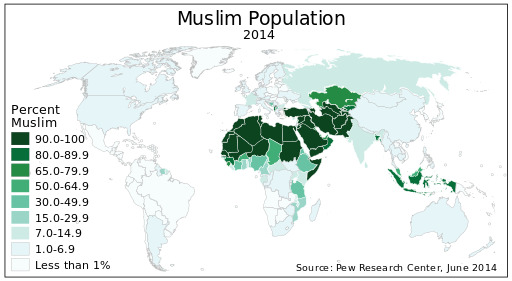
As pointed out during the Weapons of Mass Destruction campaign and Bush: Deux, Islam isn’t the enemy, as we have allies in Saudi Arabia, Indonesia, Malaysia, Morocco...actually, most of them, at some time. If you’re worried about Islam, go make a friend who’s Muslim and you’ll be happier. If you’re worried about extremist--whether black, brown, or white--the answer is to improve their standard of living. In fact, for you Europeans who are thinking of protecting your country against the influence of refugees, just know that that’s exactly what George W. Bush would have said. You hated that guy. So did I. Don’t fall for him. You’re better than that. Use your creativity and innovation to deal with this in an un-Bush-ly manner.
And when compared to our current and recent allies, the Clash of Civilizations model simply doesn’t hold water. I didn’t buy the rhetoric during Bush Deux and I don’t buy it via S. Harris. Reagan didn’t buy it either, as he sent weapons to Afghanistan to fight the clash with the other spectre: Communism. Not even Trump really buys it. Actually, most of the countries we are fighting in, have been fighting in, funding military conflict, or have special operations aren’t Muslim, they’re Christian. As of 2014, the U.S. had around 134 countries that SOCOM, SOF, training of foreign militaries that was going on. Central & South America. Southeast Asia. Pacific Islands.

(Christian countries)
Apart from their selective cartographic interpretation, they (Bush, Harris, Huntington, but not CIA) also completely omit the civil rights issue pertaining to discriminating against Muslim Americans, which can be traced back to Civil Rights movement, Louis Farrakhan, Malcom X, et al. Discrimination against Muslims is not only illegal under Constitutional right to the Freedom of Religion, but it savagely and disproportionately effects people of color. If Harris preferred a logical, historical continuity, the lines of discrimination are much more ardent than the clash between civilizations in this country and others. And so, calling it the BS that it is catalyzes the liberal left’s defense of Islam: that it’s a false pretense.
The contradiction of Harris, and much of what’s come to be the Nationalist movement across many European countries, that declare the inhumane treatment of outsiders (refugees, immigrants, even citizens of other cultures), is quickly shown outlined in the uncivil actions necessary to maintain the alleged civil society. (But then, is it still civil? Was it ever?) Logically, it’s congruent to the camp that believes the death penalty is necessary to ensure that killers don’t kill in a society where killing isn’t allow or you have to bomb to get peace. What’s curious about Harris and Nationalists who advocate violence to ensure peaceful society is that they never advocate for greater support of non-military organizations whose missions more acutely align with these proposed ideals: Amnesty International, for example, works for human rights not only abroad but also within these “civil societies.” They are just one of the many organizations, non-military organizations, that work to do exactly what this contradictory camp suggests, though without contradiction.
#travel ban#Trump#secularism#civil society#divine intervention#islam#christianity#holy war#isil#spontaneous combustion#sam harris#noam chomsky
0 notes